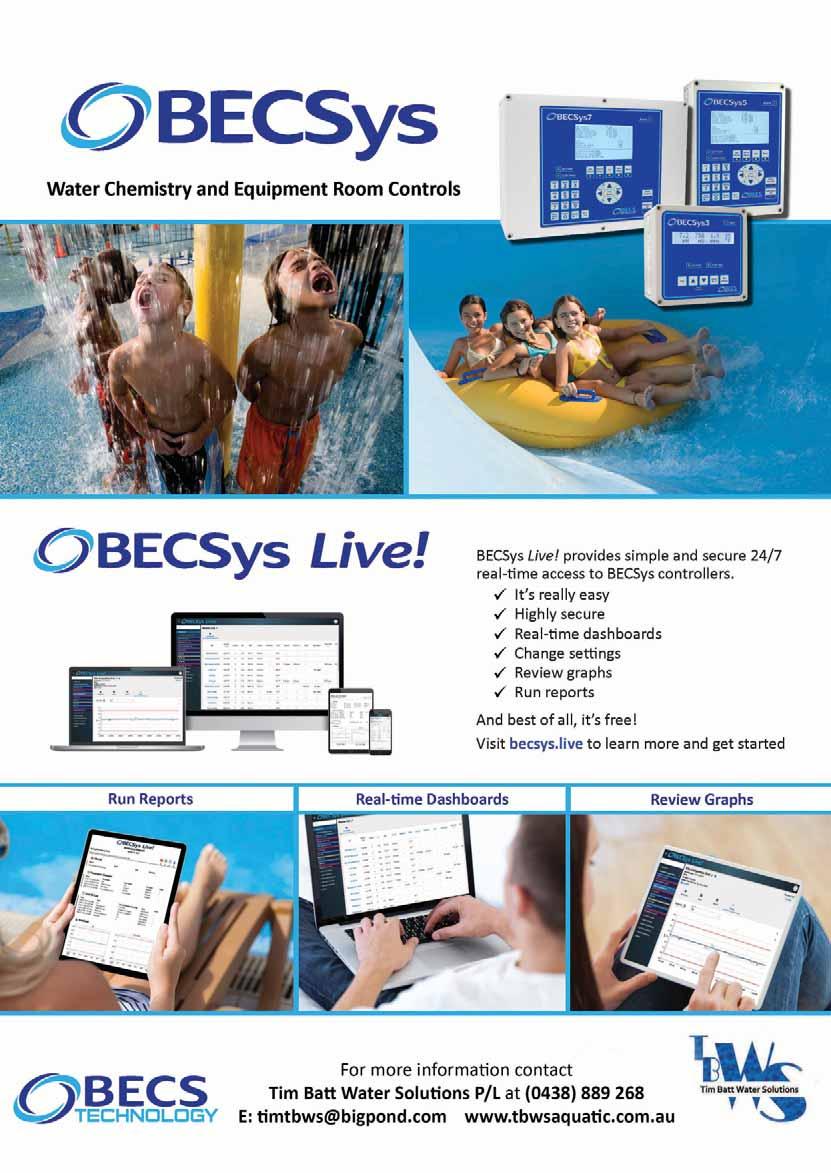
















Your scalable open software platform for fitness clubs and leisure centres.











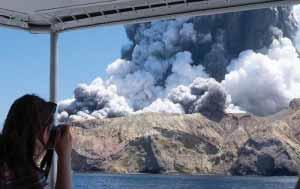














Published by
Leisure Media Limited
c/o 45/30 Nobbs Street
Surry Hills NSW 2010
AUSTRALIA
ABN 33 673 565 609
Tel: 02 8018 6808
E-mail: leisure@ausleisure.com.au www.ausleisure.com.au www.facebook.com/ausleisure
Editor Karen Sweaney
Publisher Nigel Benton
Managing Director Lindsay McGrath
Advertising Inquiries
Nigel Benton Tel: 0411 551 731
E: nigel@ausleisure.com.au
James Croll Tel: 0488 090 904
E: jcroll@ausleisure.com.au
Printed in Australia by Pegasus Print Group
Building B, 1A Bessemer Street, Blacktown NSW 2148
Tel: 02 8822 0600, www.pegasusprintgroupcom.au
Annual subscriptions cost $99 in Australia and New Zealand. Details at subscribe.ausleisure.com.au or call 02 8227 6486.
Members of ARI NSW, ARQ, ASSA, ExerciseNZ, IAKS, LIWA Aquatics, the Sports and Play Industry Association and the VMA receive the magazine as a membership benefit.
The views contained in Australasian Leisure Management are not necessarily those of Leisure Media Limited or the Editor. While every care is taken with advice given, Leisure Media Limited and the Editor can take no responsibility for effects arising therefrom. Views expressed by contributors may be personal and are not necessarily the views of their employers or professional bodies/associations.
© Leisure Media Limited, 2024. ISSN 1446-1374




While many industries are united in their representation, sharing of information, lobbying and support of stakeholders’ interests it’s sad to say that much of this industry is far from being in that position - a situation little different from when this publication was launched 162 issues ago.
The opportunity that existed for the launch of Australasian Leisure Management was that there was no single media platform that covered the management of what the population does in its out-of-home free time - reporting on learnings and best practice - based on a commitment to the sharing of information for the benefit of those with a professional and business interest in the industry.
But more than two decades on, much of the industry remains fragmented with duplication of activities, inter-sectoral rivalries and not enough information shared.
As we have reported before and as covered in the article ‘Caught in the Crossfire’ on page 62 of this issue, Australian Sports Commission (ASC) Chief Executive Kieren Perkins has been highly critical of current governance models in sport, noting that “the federated model for sport guarantees obstruction and oblivion”.
Here, too many bodies seemingly exist for the benefit of their board and a small number of long-serving members rather than the wider industry, with too much information held and owned and, all-too-often, not shared.
Indeed, our desire to communicate is sometimes viewed with suspicion by those who look to derive a competitive advantage from their knowledge - confirming to the ‘knowledge is power’ mantra.
And operationally, even the ASC does this, posting its media releases a day before distributing them in order to seemingly gain a ‘first mover’ competitive advantage with online search engines.
And for those who rely on social media for their communications, a few posts to a closed group on LinkedIn (once aptly dubbed ‘Facebook for suits’) or other social media channels is not a thorough way of communicating with the industry and its stakeholders.
Before I offend, I will call out the organisations that, as noted on the cover, work with us as being the exception to this.
I also note encouraging moves such as Aquatics and Recreation Victoria and Life Saving Victoria announcing that they will come together for this year’s Victorian Aquatics and Recreation Industry Conference.
It’s also worth highlighting an upcoming industry workshop/ strategy summit that aims to attract industry leaders to chart the future of aquatic and recreation that will be held on the Gold Coast on 23rd August.



Australasian Leisure Management is


Driven by Aquatics and Recreation Queensland under the banner of the Aquatic Recreation Network Australia, the event Summit will feature discussions on industry trends and challenges, a look at actionable strategies for growth and innovation and networking connections to elevate business and the aquatic and recreation industry.
A recent disappointment for the industry has been Federal Treasurer Jim Chalmers failure to include wellness measures advocated by AUSactive in Australia’s budget for 2024/25.
AUSactive had, in a widely publicised campaign, advocated for Fringe Benefit Tax exemptions for employer provided gym memberships, tax deductibility for gym memberships for all taxpayers and a national public health campaign developed with key stakeholders to promote the uptake of physical activity and exercise in all forms.
While non adoption of these measures is a setback, AUSactive’s campaign, which it has vowed to continue, deserves massive recognition of what a united industry can achieve.
Nigel Benton, Publisher







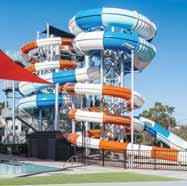




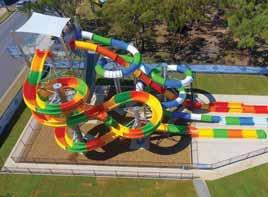




















Some of the industry headlines over recent months. Daily industry news can be read at www.ausleisure.com.au

A period of ongoing changes in Netball Australia’s management appears to have ended with the sport’s Board of Directors electing Liz Ellis as its new Chair.
The nine-member Board voted for Ellis, who only joined the board in April, to succeed Wendy Archer. Ellis, who chaired the sport’s State of the Game review in 2020, said that locking in future financial sustainability would be key among the Board’s priorities, adding “netball is in a healthy position. We’re seeing record crowds at Suncorp Super Netball and growing broadcast audiences this season at the same time as revenue from our commercial partners is growing.”
Ellis was a member of the national team from 1993 until 2007 and is the most capped Diamond ever.
Netball Australia has also appointed Stacey West as its new Chief Executive.
More news on industry appointments can be read on page 65.
Melbourne-based seating supplier Camatic Pty Ltd has been revealed to have accrued debts of $29 million prior to its entering voluntary administration in March.

In a move to bring together key leisure sectors including sport while refocusing the arts, hospitality, tourism and the night-time economy portfolios, the NSW Government has announced the creation of a Department of Creative Industries, Tourism, Hospitality and Sport
Rolling Venues NSW, the NSW Institute of Sport and the Office of Sport into elements of the Department of Enterprise, Investment and Trade portfolio, the new Department will, according to NSW Minister for the Arts and Minister for Jobs and Tourism, John Graham “support the Government’s commitment to cultivating thriving creative industries and nighttime economies across the state.”
The changed department will commence operations from 1st July.

As exclusively revealed by Australasian Leisure Management in mid-April, the 60-year-old company, which employed more than 70 staff, which traded as Camatic Seating, designed, manufactured and installed seating in stadiums, arenas, cinemas, theatres, educational institutions and mass transit locations around the world.
The Sunshine Coast and Moreton Bay region has achieved a remarkable physical active milestone, with the Million Moves Challenge achieving two million moves across the 21-day challenge that ran through May.

More than 1,300 people from the region pledged their commitment to complete a minimum of 75 moves each day for 21 days to highlight 75% of Australians are not getting the recommended amount of physical activity.
AUSactive has also launched its first Digital Futures Research Report, providing insights and data from more than 450 businesses that can be used as benchmarking tools for how health and fitness businesses can embrace technology for future growth and greater efficiency.
Southern Grampians Shire Council has adopted the 20232033 Plan for Nature, with the plan aiming to deliver a shared vision to protect and enhance the local biodiversity and natural values across the Shire.
Highlighting the importance of the Shire’s environmental and landscape assets, which he says are crucial to the local ecosystem and tourism industry, Southern Grampians Mayor, David Robertson advised “we are very fortunate to be surrounded by an outstanding natural environment here, with the Grampians National Park, the Glenelg and Wannon Rivers and ancient Volcanic plains attracting visitors year-round, and fertile farming land supporting a prosperous economy.”
Global ticket reseller Viagogo has lost a six-year legal battle against the New Zealand Commerce Commission after being found to have repeatedly misled customers in claims that its website was an official ticketing outlet.
The High Court has found Viagogo used tactics to drive sales and induce ticket-buyers to pay an inflated amount of money for tickets with High Court Justice Mary Peters ruling that many of the tactics breached New Zealand’s Fair Trading Act, as they were likely to mislead people looking to buy tickets to concert and sporting events.
Justice Peters agreed with the consumer watchdog’s assertion that 90% of the tickets resold through the Viagogo website were sold by professional ticket scalpers with intent to resell for profit.
undertaking consultation on
Austrade - the Federal Government’s international trade promotion, investment and visitor attraction agency - is currently conducting a consultation on the next phase of the THRIVE 2030 visitor economy strategy, inviting industry stakeholders to have their say in shaping the long-term sustainable growth of the sector.
Aiming to return tourism and the visitor economy to prepandemic visitor spend and sustainable growth, with targets of the industry to $166 billion by 2024 and $230 billion by 2030, THRIVE 2030 is industry-led and government-enabled.
An industry workshop that aims to attract industry leaders to address the future of aquatic and recreation is to be held on the Gold Coast on 23rd August under the banner of the Aquatic Recreation Network Australia.

To be held at Gold Coast Convention and Exhibition Centre alongside the SPLASH! exhibition, the invitation-only ARNA Aquatics and Recreation Strategy Summit 2024 will feature discussions on industry trends and challenges, a look at actionable strategies for growth and innovation and networking connections to elevate business and the aquatic and recreation industry.
Event host Aquatics and Recreation Queensland note that the Summit is “carefully curated for industry leaders, innovators, and decision-makers.”
Following the success of the Ignite Fitness Business Summit in 2023, the event is returning in August as two events held over consecutive days in Melbourne.

Organiser Mel Tempest advises that the Ignite Fitness Business Summit with its dynamic roundtable format will be held on 2nd August and the pioneering Ignite Women’s Health Summit will follow on 3rd August.
Tempest advises “with two days of impactful learning and networking with new speakers and new sponsors, these events are designed to inspire, educate and elevate the fitness industry.”

Making the most of fine summer weather and a strong events line up, Auckland Stadiums have reported that over 220,000 visitors were welcomed to its venues.
Auckland Stadiums (a division of Tataki Auckland Unlimited) operate three stadia across the region - Go Media Stadium Mt Smart, Western Springs Stadium and North Harbour Stadium.
The full return of stadium events this summer has had a positive impact on Auckland’s economy, with the hospitality and tourism industries benefitting from the boost in visitor numbers.

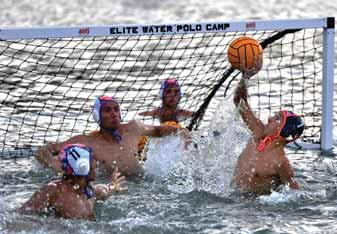


In an Australian-first at a major stadium, the Adelaide Oval will now accept cryptocurrency as a means of payment with patrons now able to purchase food and drinks at the venue.
The initiative, made possible through the payment solution of Crypto.com, is supported by Adelaide Oval, Adelaide Crows and financial systems software firm DataMesh, which is supplying the payment technology and terminals.
Starting from the AFL’s ‘Gather Round’, various F&B outlets within Adelaide Oval can now accept the cryptocurrency.
Gymnastics New Zealand amends attire rules to allow shorts to be worn over leotards

Gymnastics New Zealand has revamped its attire rules to allow competitive gymnasts in all codes to wear shorts or leggings over their leotards.
The overhaul of the sport’s attire regulations will also end the practice of athletes being penalised for visible underwear and bra straps during competitions in the country.
The governing body advised that it had made the changes after a survey of competitive gymnasts, which garnered over 200 responses, which found the athletes wanted to “feel comfortable and safe” in the sport.
Viva Leisure launches $16 million equity raising to fund new acquisitions
Australian Stock Exchange listed fitness operator Viva Leisure has announced the launch of a fully underwritten $16 million equity raising to complete two acquisitions.

The fundraising is to support Viva Leisure’s binding agreements for two strategic acquisitionsthe adding of eight health club locations in Western Australia and the expansion of the Club Lime brand in this market, complementing the group’s existing 14 Plus Fitness corporate locations in the state.
The company has also advised of the completion of the rollout of its Viva Pay across the entire Plus Fitness network, marking a new era in membership management and payment processing for the group. Transforming membership management and payment processing, the Hub membership management system and Viva Pay is now in place for Plus Fitness’ 192 locations across Australia.

Fitness education provider Clean Health has announced the acquisition of the Australian Institute of Fitness (AIF), Australia’s largest fitness educator.
In making the acquisition, Clean Health aims to enhance AIF’s legacy while solidifying its mission to educate over one million fitness professionals by 2028.
Advising of the acquisition, Daine McDonald, founder, coChief Executive and Chairman of Clean Health, stated “since 1979, AIF has been the original market leader in personal trainer education in Australia, educating over 100,000 students in personal training and massage qualifications over the last 45 years.”
QRL’s green socks campaign supports young rugby league referees

Aiming to combat increasingly negative sideline behaviour and growing abuse aimed at young officials, the Queensland Rugby League (QRL) has launched ‘Green Socks’, an initiative that indicates if a referee is under the age of 18.
Guided by 10 key pillars from respect for officials to ensuring enjoyment for all involved in the sport, QRL Chief Executive, Ben Ikin stated “we’ve introduced the slogan ‘If my socks are green, I’m under 18’, to make sure that people understand, if you lose your temper at a junior rugby league match official, you could be verbally abusing a minor.”
Ikin explained that while passion in sport was encouraged, there was a limit to what types of behaviours qualified as acceptable, especially when considering the participation of junior officials.
to swim partnership
BlueFit has announced a partnership with Fitness and Lifestyle Group (FLG), the operator of leading exercise brands Fitness First Australia, Goodlife Health Clubs, Zap Fitness, California Fitness and Jetts Fitness New Zealand.
This partnership will see BlueFit licence the pool areas in over 20 Fitness First and Goodlife facilities across Australia.
As part of this collaboration, BlueFit will drive the growth of the learn to swim programs and maintain the pool and plant areas at FLG locations. This strategic partnership combines the strengths of both organisations to improve product offerings to the local communities across Australia.
The partnership launched in January and is a long-term commitment from both brands.
Swim Coaches and Teachers unveils revolution in swim teacher qualifications

Swim Coaches and Teachers Australia, the peak body for education for swimming coaches, swim teachers and swim schools has launched its newly developed ‘Gap’ training program.
The training program is aimed at empowering swim instructors with advanced knowledge and skills. The program also fills the gap between the previous module of the SISSS00112 Swimming and Water Safety Teacher, which was superseded in Training.gov.au (VET) in coordination with the Australian Skills Quality Authority (ASQA) review cycle, to the new and current module SISSS00132 Swimming and Water Safety Teacher qualification.
The Gap training program serves as a significant addition to the education of swim teachers, allowing the aquatic professionals to enhance their professional profile and opening doors to new opportunities within the industry.

Event specialist, Showtime Event Group, has won the tender for catering and venue management at the Melbourne Town Hall (left).
Quayclean Australia, has been awarded the cleaning and presentation contract by Venues NSW for Accor Stadium at Sydney Olympic Park, CommBank Stadium in Parramatta and Wollongong’s WIN Stadium and Entertainment Centre.

The City of Whittlesea has appointed Belgravia Leisure as the facility managers for its aquatic and recreation centres - Mill Park Leisure, Thomastown Recreation and Aquatic Centre and Whittlesea Swim Centre (left).
The City of Darwin has announced that The Y Northern Territory will continue to manage its three community pools, including the soon-to-open Casuarina Aquatic and Leisure Centre.
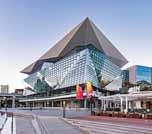
ASM Global has been contracted to operate the International Convention Centre Sydney for a further 10 years of the 25year Public Private Partnership following a gold star report card for 10 years of delivering extraordinary results for the Darling Harbour Live consortium and NSW Government.
Camden Council, located in Sydney’s south-west, has announced BlueFit as the new operator of Mount Annan Leisure Centre, Camden War Memorial Pool and the soon to open, $63 million Oran Park Leisure Centre.

MMA app Alta Group Global raises $US6.5 million
NSW-based Alta Group Global, which operates a mixed-martialarts training app, has raised $US6.5 million ($9.9 million) through a listing on the New York Stock Exchange (NYSE).
Operating a technology platform that allows gyms to run various mixed-martial arts and combat sports training programs, including Alta’s Warrior Training Program, UFC Fight Fit, and the Alta Academy, Alta Global, formerly known as Wimp 2 Warrior, trades under the symbol MMA - acknowledging its core 20-week training program product.

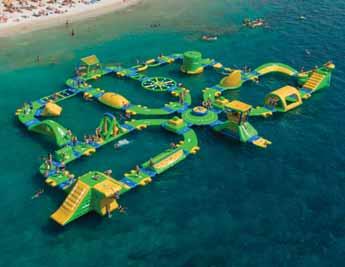
As the official partner for Wibit in Australasia,MIZU Leisure and Sports is your ultimate partner in providingquality water attractions. We offer a diverse and carefully curated product line for businesses seeking to create or to elevate their offerings, whether it be a heart-pounding adventure or a leisurely day by the water.
Work with MIZU today & together, let’s build landmarks and make waves!

MIZU LEISURE AND SPORTS www.mizusports.com
Tammy Kelly | tammy@mizusports.com
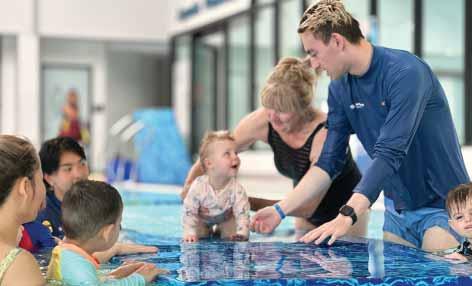
26% rise in GOswim learn to swim enrolments
In partnership with Swimming Australia, leading learn to swim provider Belgravia Leisure has announced that in the past two years, there has been a 26% uplift in their GOswim learn to swim classes.
While the enrolments demonstrate an appetite from parents and carers for their children to possess water safety skills, Belgravia Leisure notes that providing these classes has come with challenges, particularly due to the national shortage of swimming teachers across the industry.
It advises that, with demand for learn to swim classes far outweighing supply, many learn to swim programs have waitlists and/or limited availability.
Group fitness managers at Fitness and Lifestyle Group’s Fitness First and Goodlife Health Clubs, with the support of the United Workers Union (UWU), have secured victory in a longstanding wage dispute.
The staff at clubs in the two chains gained the support of the UWU after Fitness and Lifestyle Group (FLG) management announced an organisational change as of August last year which would have seen lower pay for many instructors and a new scheduling regime with less flexible work hours.
However, with a UWU online petition - highlighting that staff in both groups had been paid at the same rate, $42.50 per class for the past 15 years - winning the support of thousands when it went viral, FLG management changed tack.
Adelaide Venue Management reveals plans for operational sustainability
Adelaide Venue Management (AVM) has unveiled its inaugural Environmental Social Governance (ESG) strategy, highlighting a commitment to act as a ‘force for good’ in the events and venue management industry.
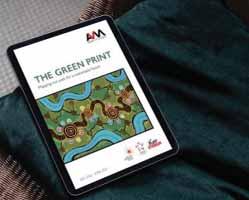
As operators of Adelaide Convention Centre, Adelaide Entertainment Centre and Coopers Stadium, AVM’s
The Green Print four-year plan, maps a path to a more sustainable future, minimising the organisation’s environmental footprint and maximising its positive impact on communities.
The Green Print builds upon AVM’s unwavering commitment to delivering responsible events, with initiatives closely aligned to State and Federal sustainability targets, and the United Nations Sustainable Development Goals.
Funlab has launched revamped branding for its Strike centres, aiming to show consumers that Strike is so much more than just bowling.
In an effort to modernise and bring more energy into the Strike brand, the new branding includes strategy, identity and experience and presents the brand as being “full of more energy than ever”, hoping to “deliver the brand’s magic into the real world”.

Commenting on the new branding, Funlab Chief Marketer, Oonagh Flanagan stated “it’s bright, it’s vibrant, it’s fun and it’s inclusive - all of the things we know and love about this wonderful brand.
“I am excited to see how guests old and new react.”
Ticketmaster impacted by massive alleged hacking breach
Ticketmaster, the world’s largest ticket seller, is reported to have been impacted by a massive data breach with a group of hackers saying they have stolen the personal details of 560 million of the company’s customers.
ShinyHunters, the group claiming responsibility, says the stolen data includes names, addresses, phone numbers and partial credit card details from Ticketmaster users worldwide. The group are reportedly demanding a US$500,000 ransom payment to prevent the data from being sold to other parties.
The data breach is understood to include the details of 500,000 Ticketmaster users in Australia, where it was first reported.
Ticketek Australia has also advised that the names of some of its customers, as well as their dates of birth and email addresses, may have been accessed in a data breach.

The Town of Port Hedland has marked the five year anniversary of the launch of the Port Hedland Leisure brand and 2019 commencement of the in-house management of its aquatic and recreation facilities.
Cheye Hill, the Town of Port Hedland’s Manager - Recreation and Leisure Services set out the achievements of Port Hedland Leisure, citing a 200% rise in overall income, 300% increase in overall attendance and 100% greater facility utilisation over the previous three years.
2024 National Congress to be held in Victoria’s Yarra Valley
Gymnastics Clubs Australia has again announced a regional venue for its 2024 National Congress, with the event to use Victoria’s Yarra Valley Lodge as its primary venue.
The location follows previous editions of the GCA Congress being held in Tweed Heads and Darwin.
The Congress will feature two days of conferencing (22nd and 23rd July), including an Emerging Leaders stream, preceded by an Insights Tour on 21st July of three clubs, trekking from Melbourne Airport to the Lodge.
Liquidators appointed to company behind planned Sunshine Coast resort and waterpark
Sanad Capital Pty Ltd, the company behind a planned multimillion dollar resort, surfing lagoon and waterpark on the Sunshine Coast, has been forced into liquidation
According to Australian Securities and Investments Commission (ASIC) documents, Liquidator Tracy Knight from Bentleys, was appointed to the company by a Supreme Court order on 24th April.
The company was behind plans to build the Actventure attraction, estimated to cost around $350 million including a wave lagoon on Steve Irwin Way in Glenview.
Sanad Capital founder Bradley P. Sutherland placed his separate company, Nurrowin Pty Ltd, into voluntary administration at the end of last year.
Australian Olympic Committee reveals $4 million for 2023
The Australian Olympic Committee (AOC) has announced a $4 million surplus for the year ending 31st December 2023.
AOC President Ian Chesterman advised of a year with strong growth and initiatives in the body’s community programs; the development of an outstanding leadership team as preparations advance for Paris 2024; excellent results for the Australian team at the Pacific Games in Solomon Islands; the development of a strong legacy strategy for Brisbane 2032; and a robust financial performance with surplus for the year of $4 million.
www.ausleisure.com.au for all the latest industry news
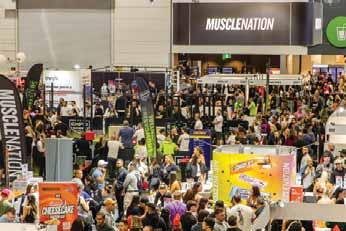
AusFitness Industry looks to gather together Australia’s fitness and exercise professionals
The 2024 edition of AusFitness Industry is looking to set a new standard as the largest and most influential fitness trade event in Australia, showcasing a record number of both local and international fitness brands and innovators.
Scheduled to run from 11th to 12th October at the International Convention Centre in Sydney, the event is designed for all those involved in the exercise and active health industry: gym and fitness centre owners, managers, buyers, and decisionmakers from diverse facilities including gym chains, franchises, independent studios, universities, councils, and professional sports organisations.
The event is co-located with the Southern Hemisphere’s biggest fitness consumer show, AusFitness Expo, running from 11th to 13th October.

With the NFC module, it is now possible to use the NFC chip of the mobile phone to pass through a gate. Compatible with both Android and iOS wallets, this is perfect for use in stadia and arenas. The process is fast, contactless and allows you to keep your ticket on your smartphone. In addition, all barcode and QR-Code tickets can be read using the SMART SCANNER, meaning swift entry for all fans. teamaxess.com
Team Axess Australia Pty Ltd | David Brown | d.brown@teamaxess.com

Campbelltown City Council has opened its long awaited Billabong Parklands, giving the local community the opportunity to experience the innovative recreation space.
Located in the suburb of Bradbury, opposite the Campbelltown Art Centre, Gordon Fetterplace Aquatic Centre and the Bradbury Oval, the four-hectare site features water play features, expansive lawn areas, pavilions with change facilities, picnic areas with seating, winding pathways, shade structures, natural tree cover and garden beds with native plants.
Its centrepiece is the 16,000 metre² Billabong swimming pool, which includes rockpools inspired by the rapids, waterfalls and rock pools of the Dharawal National Park, a 2.5-metredeep lagoon and a zero-depth water play area with a range of interactive water elements.
Expectation of July 2025 completion for Parakiore Recreation and Sport Centre
Building contractors CPB has advised infrastructure delivery body Rau Paenga expects to have construction of Christchurch’s much delayed Parakiore Recreation and Sport Centre completed in July 2025.
New Zealand’s largest indoor sport and aquatic facility, which will be owned and operated by Christchurch City Council, will then go through a 12-week commissioning process once construction is completed before its opening to the public.

Following several tragic incidents resulting in death, Cairns Regional Council is undertaking an audit and review of natural areas and waterways in its area to identity potential ways to improve safety.
The audit and review will be included as a component of the Aquatic Strategy that will be presented to Council at a workshop in mid-2024.
The tragic incidents occurred at local waterways, including Isabella Falls in December 2023 and on 7th April 2024, and at Crystal Cascades on 10th March 2024.
Council’s audit, will include Crystal Cascades and Isabella Falls, and will reference learnings from a comprehensive review of safety at The Boulders, Babinda, in 2022, which was adopted by Council in January 2023.
Leading exercise brand Anytime Fitness has marked 16 years since its Master Franchise agreement was signed for Australia.
To enhance its members’ experience in clubs across Australia, Anytime Fitness launched AF SmartCoaching technology and AF App in January.

AF SmartCoaching provides Anytime Fitness members with personalised coaching that can be accessed via the app anytime, anywhere. The app also features the ability for members to upgrade to the AF Access Pass and enjoy the convenience of opening the door to clubs around Australia with their smartphone.
Aiming to redefine the sport, Gymnastics Australia, in conjunction with the State and Territory bodies, have launched the new ‘Discover The Freedom’ campaign nationally.

The campaign aims to encourage Australians to use gymnastics as a platform for personal growth and selfexploration.
For challenges facing the sport see the feature on page 62.
New association formed of International Federation of Swimming Coaches

Aiming to support coaches worldwide, four of the world’s largest national swimming coaches associationsfrom the USA, Australia, Canada and Great Britain - have come together as founders of an innovative alliance called the International Federation of Swim Coaches Associations (IFSCA).
Representing the world’s major aquatic powerhouses, the coming together of the Swim Coaches and Teachers Australia (SCTA), American Swimming Coaches Association (ASCA), Canadian Swimming Coaches Association (CSCA) and British Swim Coaches Association (BSCA) as IFSCA will see a collective push to ensure coaches can project their voices from the pool deck to the boardrooms for the betterment of coaches worldwide under this new, transparent international banner.
Brisbane live music venue ‘The Zoo’ has announced that it will cease operation this July after 32 years in business, with owners saying that the venue is not financially viable.
The 500-capacity venue, which opened in 1992, is one of the longest standing live music spaces in Brisbane’s entertainment hub Fortitude Valley.
During its history, it has played host to thousands of artists from Australia and overseas, including artists such as Powderfinger, Lorde and the Pixies.
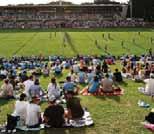
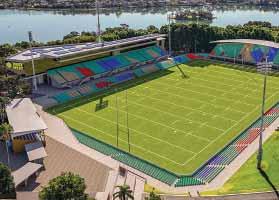
million investment into Sydney’s
The Federal and NSW Governments and venue owner, the Inner West Council, have announced a $40 million joint investment into Sydney’s Leichhardt Oval.
The fund includes $20 million from the Federal Government, $10 million from the NSW Government and $10 million from the Inner West Council which will be used to raise the venue’s seating capacity by 3000 seats, develop a new northern grandstand and add new female-friendly change rooms.
The development will be led by the Council, drawing on its master plan for the venue.

Cedar Mill Group, founded by Winarch Group’s Paul Lambess, has acquired Musos Corner, a popular fixture within Australia’s music scene. This acquisition honours the legacy of Musos Corner’s past under the stewardship of the Lindsay family, while also setting the stage for a promising future for the business.
Musos Corner is Australia’s number one independently owned music retail store, based in Newcastle. Founded in 1967 by Ian and Sandra Lindsay, the store’s legacy spans over 57 years and is built on an unwavering dedication to musicians and a commitment to offering a diverse range of brands catering to every budget.

While early season snowfalls in Australia’s Alpine region have been erratic, NSW and Victoria’s ski resorts are turning to snowmaking to boost the first part of the winter sport season.
While the levels of natural snow have varied over the last few years due to La Niña, WeatherZone advises that lower levels of snow could be expected in coming years due to global warming with warming temperatures over the past few decades leading to a decrease in snow depth, which has in turn made ski seasons shorter.
The process of snow making involves blasting a mixture of chilled mountain water and compressed air through a snow gun.

With a new governance structure for New Zealand Rugby failing to gain approval at a recent special general meeting in Wellington, the New Zealand Rugby Players Association (NZRPA) has announced its intention to establish a separate body to run the professional game.
The proposal for a wholesale reform of the game, which would have included a fully independent board, backed by the NZRPA and the NZ Maori Rugby Board, received only 31 votes in favour while 59 were opposed.
Instead, Proposal 2, a Provincial Union Governance model which secures three places on the nine-member board for people with previous provincial board experience, was passed.
The SGM was prompted by last year’s Pilkington Review, which indicated New Zealand Rugby’s organisational structure and constitution was “not fit for purpose in the modern era”.
www.ausleisure.com.au for all the latest industry news
Creative Australia report outlines role of music festival sector and the challenges it faces
Creative Australia has released a research report entitled ‘Soundcheck: Insights into Australia’s music festival sector’providing an overview of the role and contribution of festivals within the broader creative industries as they face multiple challenges.
Billed as the first widespread report of its kind, it highlights the cultural, social and economic impact of Australian music festivals, including information on ticketing and attendance trends during the 2022/23 financial year.

Spanning the 535 music festivals held nationwide in that time, the 116-page report reflects the scope, scale and diversity of the Australian music festival landscape.
The report reveals that the average cost to run a music festival is $3.9 million while only 56% of music festivals in 2022/23 were profitable (with a median profit of $731,579)more than one in three music festivals reported a deficit (35%, with a median deficit of $470,000).
Festival organisers nominated rising operational costs as having the most severe impact on almost half of festival organisers (47%) with overheads including artist fees, production, suppliers, freight, transportation and insurance.
The leading players within the global tourism industry have published an insightful and action-orientated report setting out their joint plan to help halt and reverse biodiversity loss.

Recognising that the sector has a critical role to play in protecting and conserving biodiversity, the Nature Positive Tourism approach is designed to be a touchstone for actionable change. It focuses on equipping the sector with the tools and insights needed to nurture and protect destinations upon which it depends.
The report, which follows the 2022 WTTC report “Nature Positive Travel & Tourism”, includes practical frameworks and real-world examples that encourage both tourism providers and tourists to embark on journeys that contribute to conservation of natural treasures.

Leading 24/7 fitness franchise Snap Fitness has recorded a 504% increase in franchise enquiries across three years, and in the past year alone recorded 42 new franchise sales across Australia and New Zealand.
The global fitness brand is experiencing significant and consistent growth in franchise enquiries, with an incredible 204% increase from 2021 to 2022, followed by a 98% increase from 2023 to 2024.
In 2020, the Australian Fitness Academy highlighted the expectations for the fitness sector to continue to grow, with an anticipated annual growth rate of 10.7% by 2027.

public and play spaces opened at Sydney’s Darling Harbour
The NSW Government is encouraging Sydneysiders and visitors to rediscover Darling Harbour with the recent opening of three new public spaces.
A state-of-the-art playground, a sound shell in Tumbalong Park and a bamboo forest walk in the Chinese Garden of Friendship have been opened to the public as new enticing places that the NSW Government hopes will draw more crowds to the harbourside precinct.

The Western Australian Government will invest $8.1 million to develop the first stage of a sustainable tourism development at the Houtman Abrolhos Islands - boosting the $16.8 million already delivered by the State Government for the Abrolhos Islands.
The archipelago of more than 200 islands, west of Geraldton, boasts diverse ecosystems, abundant wildlife and a rich heritage, making it a popular destination for local, national, and international tourists.
Business case released for Northern Territory AFL team and Darwin City Stadium
A strategic business case for the Northern Territory to have its own AFL team has been released by the Australian Football League Team Northern Territory Taskforce.
The Business Case also puts forward an aspiration for a future multi-purpose Darwin city stadium, where a Territory AFL team would be based.
The Taskforce’s strategic business case includes a 10year plan to establish a Northern Territory (NT) based AFL club.


With 30,000 fans having attended Fisher’s inaugural Out 2 Lunch Festival at the Gold Coast’s Coolangatta Beach on 4th May, promoter TEG Live claims that the event has made history as the largest beach party to ever be staged in Australia.
TEG Live has also reported that the Festival injected $50 million into the local economy, benefitting more than 200 businesses engaged in the planning and the delivery of the event across the region.
Additionally, it created 2,000 jobs to bring the event to life with TEG Live working with the City of Gold Coast, Queensland Police, and transport and traffic management consultants to ensure a smooth experience for patrons, staff, visitors and local residents.

The Tasmanian Government has confirmed it will provide $5 million in funding to prevent the closure of the Glenorchy War Memorial Pool in Hobart’s north.
Five years after the SurfnPlay Aqua Park was first proposed for a site in Dingley Village in Melbourne’s south east, the indoor-outdoor waterpark, surf lagoon and aquarium attraction has been given ‘approval to proceed’ by the Victorian Government.

A 1500 seat Broadway-style lyric theatre with First Nations inspired interiors is among the key features of the winning design for $188 million plus redevelopment of Parramatta’s Riverside Theatres.
Mildura Rural City Council has opened the $13 million second stage of the Mildura Sporting Precinct.

National Premier League Men’s NSW side St George FC, have returned to playing their home matches at their historic Barton Park venue in the Sydney suburb of Banksia following a $51.7 million upgrade of the sporting precinct.
Builders advise that construction of Christchurch’s Te Kaha stadium has reached halfway point.
A new purpose-built indoor heated pool has opened as part of a $14 million upgrade at the Kawana Aquatic Centre on the Sunshine Coast.

X-Golf Australia is expanding in the Queensland city of Toowoomba with their Keefe Street venue relaunched following extensive renovations and under new ownership.
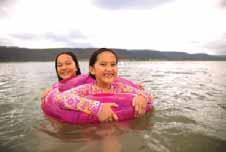
Penrith Beach first season attracts 210,000 visitors
Penrith Beach ended its first season having attracted more than 210,000 visits since its opening on 19th December 2023.
Western Sydney families enjoyed the sandy shores of Penrith Beach over summer, taking full advantage of the firstever beach season at Penrith.
The beach provided much-needed relief to the community as the temperature frequently soared towards 40 degrees. The overwhelming response from locals resulted in the extension of the season for an additional three weeks until ANZAC Day.
The iconic towers at the entrance to Luna Park Melbourne are undergoing major restoration work that will see their thematic trimmings and architecture being refreshed.

The City of Onkaparinga Council Assessment Panel has approved plans for ‘The Break Surf & Stay’ - a surf park and tourism destination on South Australia’s Fleurieu Peninsula.
City of Greater Geelong has advised that the $65.6 million community facility in Norlane which opened to the public in February this year and formerly known as the Northern Aquatic and Community Hub (NACH), will now be named Norlane ARC (Aquatic Recreation Centre).
Award winning aquatic and fitness centre Aquafit has celebrated its 20th anniversary with General Manager, Kristen Green highlighting how the facility stands out as a beacon of excellence in the fitness industry.

A new performing arts venue - The Lounge - has opened at The Concourse Performing Arts Centre, in the northern Sydney suburb of Chatswood and will be home to a diverse range of live performance.
URBNSURF Sydney wave park has been opened to the public.
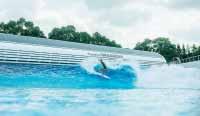
With the venue having suffered power failures and a leaking roof in recent years, the South Australian Government has announced that Adelaide’s ageing Netball SA Stadium is to get a major multimillion dollar overhaul.
After a $30 million refurbishment project, Swan Active Midland has opened its new gym and upgraded indoor sports courts and pools.


doubles to $89 million
The price of the Bundaberg Regional Aquatic Centre has been revealed as costing $89 million - almost double its projected budget in 2021 - according to figures released by Bundaberg Regional Council and Mayor Helen Blackburn.
With the cost of the project having crept up from its original price of $45 million, to $75 million and then $83 million, new information released by the council includes the full expenditure including the construction contract, design contract, project management, contract administration, waste disposal and ancillary and statutory costs.


Bronwyn Smart and James Ritchie dissect the White Island disaster and the vital lessons for safety in its wake
The White Island volcanic eruption of December 2019 stands as a poignant marker in New Zealand’s history, marking one of its most tragic episodes. Amid the dramatic beauty of this volcanic island, a cataclysmic event unfolded, claiming lives and leaving many injured.
Delving into the aftermath of this disaster and dissecting the failures that led to it, presents and illuminates crucial lessons for the future. What started as an ordinary day, this seemingly enjoyable adventure changed the lives of many.
On that fateful day, White Island roared to life, engulfed in a fiery eruption, with 47 individuals, comprising tour groups and their guides, finding themselves in the midst of a perilous situation.
The eruption resulted in the loss of 22 lives, with 25 others sustaining serious injuries. Subsequently, Worksafe NZ, the New Zealand safety regulator, embarked on an extensive investigation, leading to charges against 13 parties, including both individuals and entities. Immediately after the eruption, Phil Parkes, the then Chief Executive of Worksafe NZ, advised “this was an unexpected event, but that does not mean it was unforeseeable”.
Anatomy of the Failures
1.There was increased activity in the lead up to the eruption, and the tourists were told that the island was now rated ‘Level 2’, but with no explanation of what ‘Level 2’ meant.



2.The tourists were not provided with detailed safety briefings prior to the activity and some advised that they only received safety briefings once they were already on the island. This would indicate they were not in a position to make informed decisions prior to committing to the activity.
3.The tourists advised that they knew there were risks but they did not know or were not informed fully on what those risks were. They put their faith in the tour operators for their safety.
4.There were no instructions provided on what to do or how to respond in the event of an eruption.
5.Some of the charges laid related to the failure to conduct risk assessments and implement risk controls.
6.Some other charges were for failure to adequately inform tourists of the hazards and risks associated with visiting the island.
7.Tourists were told to wear enclosed shoes, hats and sunglasses. When they arrived on the island they were given a hard hat which they were told to wear at all times and a respirator which they were told to use if they felt they needed to. This proved to be insufficient PPE to guard against injury from an eruption.
8.In 2016, a shipping container had been placed on the island to act as shelter in case of an eruption. This was an ineffective risk control as there was an issue with its location - that it would take tourists too long to reach it - and its suitability to provide protection and resist the impact of projectiles and gases.
9.Tourists reported the only emergency response procedure was being told to ‘run’ by one of the tour guides.
10.There was insufficient first aid skill and equipment to support and treat survivors while waiting for medical attention. The first aid kits did not contain useful supplies to treat burns. The tourists who were assisting survivors tipped out the contents and used the kits to fill with water and pour over survivors burns.

11.There was insufficient radio installation for communications on the island. There was limited cell phone coverage and no fixed radio system.
The need to complete risk assessments is detailed in work health and safety legislation and applies to all organisations regardless of industry, size and location. The issue of completion of risk assessments, or lack thereof, was a common thread throughout the prosecution and trial process.
Whakaari Management Limited (WML), the owners of the island, did not engage an expert to undertake a risk assessment of the business of permitting tours to occur on the volcano. WML approached GNS Science to conduct a formal risk assessment, but this had a cost of completion, which WML did not choose to pay.
Some of the tour operators had health and safety documentation but this was deemed to be inadequate.
Much of the prosecution was based on the fact that no risk assessments were completed by tour operator or others in a formal and systematic manner. In addition, the increased activity in the lead up to the event, did not trigger the completion of risk assessments.
The ensuing 11-week trial, unprecedented in its scale, marked a pivotal moment in New Zealand’s legal landscape. Among the accused were three individuals charged as Directors for failing in their due diligence responsibilities, and 10 entities held accountable for lapses in workplace health and safety standards.
Notably, New Zealand Government agencies such as GNS Science and the National Emergency Management Agency were also implicated, underscoring the gravity of the incident.
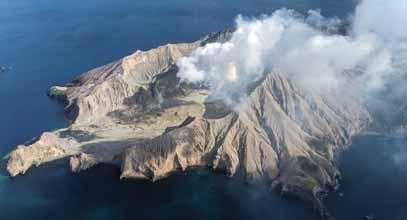
While some entities pleaded guilty or were found guilty, others saw their charges dismissed. Nevertheless, the presiding judge imposed significant reparations totalling $10.21 million, accompanied by fines and penalties. These legal repercussions underscored the severity of the lapses and emphasised the imperative for stringent safety measures in such environments.
During sentencing, Judge Thomas stated “properly assessing risk to tourists and employees caused by an eruption was blatantly fundamental … that failure exposed others to the risk of serious injury and death”.
So what can other operators learn from this tragedy to avoid similar incidents occurring?
Here is our list of five things you can focus on to prevent an incident like this.
1.Rigorous Risk Assessments: Comprehensive risk assessments are imperative for identifying and mitigating hazards associated with activities. Organisations must undertake these assessments systematically and adapt them dynamically to evolving circumstances.
2.External Expertise: Engaging external experts can provide invaluable insights into managing health and safety risks effectively. Investing in training and seeking expert guidance can enhance preparedness and response capabilities.
3.Emergency Preparedness: Planning for worst-case scenarios is paramount. Organisations must formulate robust emergency response plans tailored to specific threats, ensuring adequate provisions for medical care and evacuation procedures.
4.Legal Obligations: Understanding and fulfilling legal obligations concerning health and safety is non-negotiable. Ignorance is not a defence; organisations must proactively adhere to regulatory requirements to safeguard lives and well-being.
5.Investment in Safety: Prioritising health and safety initiatives is not just a moral imperative but also a sound investment. The cost of preventive measures pales in comparison to the human toll and economic ramifications of a disaster. This includes equipping frontline teams with comprehensive training on emergency protocols, supported by documented procedures to guide employees, visitors, and customers on safety within the workplace.
The White Island volcanic eruption serves as a sombre reminder of the catastrophic consequences of safety oversights. As we reflect on this tragedy, it is incumbent upon us to internalise the lessons learned, fortify our defences, and cultivate a culture of safety that reverberates through every facet of society.
Failure to heed these lessons would be a disservice to those who perished and those who continue to endure the aftermath of this preventable catastrophe.
Bronwyn Smart FGIA CAHRI and James Ritchie FGIA are Directors of The Mindful Risk Group. www.mindfulrisk.com.au

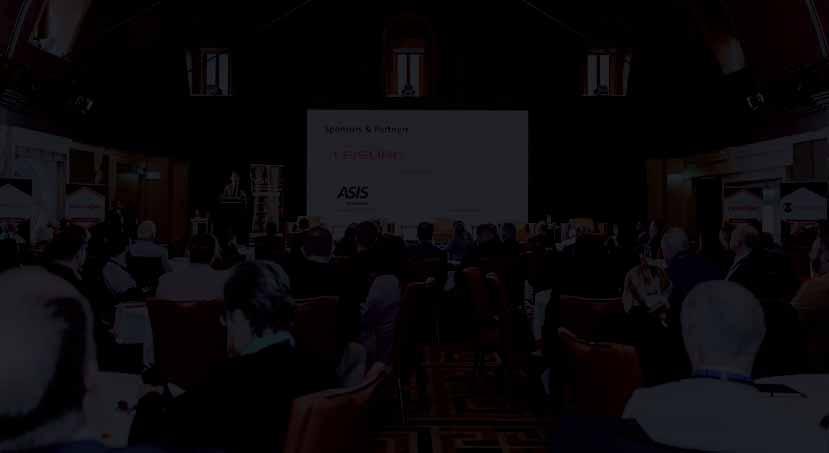
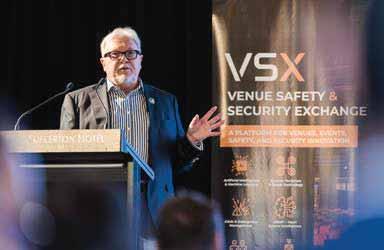






Arthur Stanley outlines how the A-Leagues found a business jewel on the Central Coast
Whenthousands of overjoyed spectators poured onto the field of Gosford’s Industree Group Stadium on the evening of Saturday 25th May - in a spontaneous reaction to the Central Coast Mariners’ dramatic A-League Grand Final win and historic football title treble - a rare jewel in the sports business industry was rediscovered.
Having previously been heavily criticised for selling off its Grand Final to Sydney, the A-Leagues took their biggest game of the year back to the fans, to a community where the passion was greatest, and created a demand for tickets like never before.
With fans clamouring to be part of the first Grand Final ever played on the NSW Central Coast - and as the home club sought to become the first in history to win all three major titles on offer in the same season - the A-Leagues was able to set a higher average ticket price to secure a very positive commercial outcome for the event.
Smaller stadium. Fewer tickets on offer. Red-hot demand.
Higher event yield.
Then, of course, there was the extraordinary event itself. An all-time record attendance of 21,379 fans squeezed into every part of Industree Group Stadium as thousands more watched on from a Live Site outside. It created the type of big-game atmosphere that sporting codes of all persuasions crave.
And the players responded with a Grand Final for the ages: the Central Coast Mariners pulling off a dramatic 3-1 extra-time win over Melbourne Victory after trailing 0-1 at the end of 90 minutes of regulation time and scoring the equaliser in injury time.
That goal by Englishman Ryan Edmondson triggered pandemonium in Gosford, with the energy ratcheting up even higher with extra time goals by 18-year-old Miguel Dipizo and a clincher by Edmondson.
But the winners on the night were not restricted to the football pitch.
Upwards of 8000 fans passed through the community Live Site at Leagues Club Park directly across from Industree Group Stadium, a high proportion of them young families with children.


Hosted by Central Coast Council and supported by Destination NSW, the lead tourism agency for the NSW Government, fans who couldn’t get a ticket or couldn’t afford them rode every minute of the drama-filled Grand Final that they could hear across the road. Memories for a lifetime.
The State Member for Gosford, Liesl Tesch, and the Member for Wyong, David Harris - the latter also the NSW Minister for


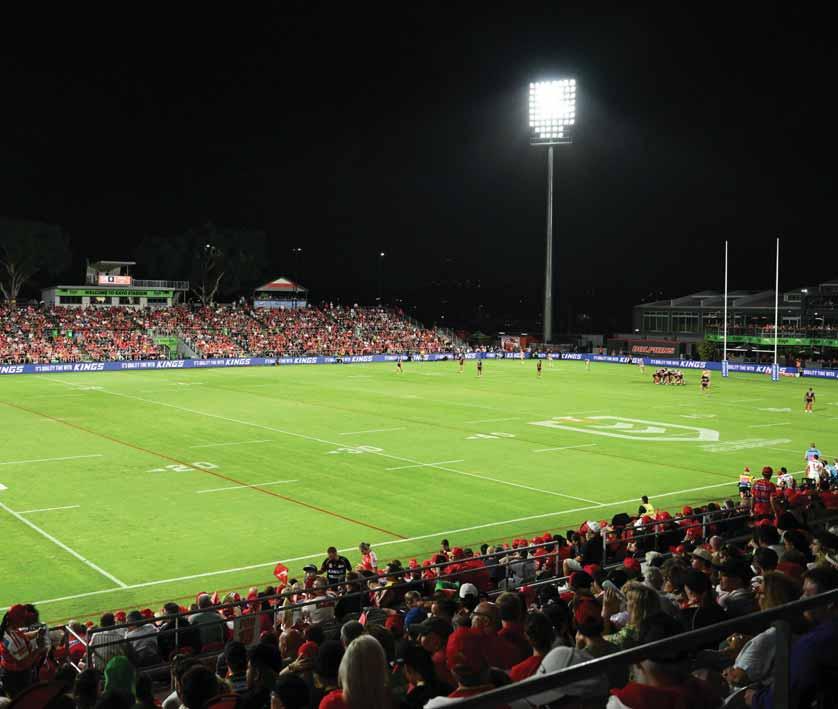

Precision Sports Lighting helped light up the game for the Dolphins to become the 17th team in the National Rugby League. Broadcast quality lux levels improves the game for everyone –players on the ground, spectators in the stand, officials on the sidelines and viewers at home.
Light up your game and grounds with specialist sports lighting expertise from Precision Sports. p ecialist S p orts .



the Central Coast - described the Grand Final as “the biggest sporting event ever seen on the Coast”, saying the event had kicked a major goal for regional tourism.
Thousands of fans made their way to the region for the game, driving visitation to new heights for this time of year and providing a boon for local businesses right along the Central Coast.
More than 4000 visiting fans arrived in support of rival team Melbourne Victory alone and helped create a phenomenal football atmosphere in and around Industree Group Stadium.
The Gosford Erina Business Chamber reported that accommodation was close to 100 per cent capacity on the Coast.
Bars, clubs and restaurants reported heavy bookings across the weekend. Fans were spilling out of Central Coast Leagues Club from lunchtime Saturday and joyous scenes continued until the early hours of Sunday.
Hotels, clubs and restaurants were packed not only in Gosford but at Wyong, Terrigal, The Entrance, Ettalong Beach, Budgewoi and Bateau Bay.
Triumph for the A-Leagues
The success of the event was a triumph for the A-Leagues who made the bold decision to take the Grand Final back to the fans and scheduled this year’s decider on the Central Coast for the first time.
It was also a triumph for VenuesLive, the experienced venue management company that took over the operations of the Central Coast stadium, on behalf of the Council, in July 2022.
The venue has been on a steep positive trajectory ever since.
Industree Group Stadium Manager Kath Casey said VenuesLive was bringing more and more content to the local stadium, which ultimately drives visitation to the Central Coast, injecting millions into the economy and creating local jobs.
Casey explained “when we bring quality events to the Central Coast, everyone in our community benefits.
“Visitation numbers increase, hotel beds are filled, and money is spent in the local community, bringing prosperity to the region and creating jobs.”
Corporate hospitality sold out for the Grand Final at the stadium within hours of going on sale and corporate functions were held at neighbouring Central Coast Leagues Club and other venues. Among the corporate guests was one of the Central Coast’s most famous residents, entrepreneur John Singleton.

Boost Mobile sponsored the cost of installing additional seating underneath the stadium’s famous palm trees at the southern end, which increased the Grand Final capacity.
Increased TV Audience
Paramount announced the live broadcast of the Grand Final had been watched by 1.12 million viewers across its streaming service and Channel 10, a figure up 12% on the previous year.
There was a marked increase in the number of viewers for the extra time component as word spread of the phenomenal Grand Final unfolding on the Central Coast.
The Legacy
Business aside, what no one can put a price on is the true value of the Grand Final being played in Gosford, with the Mariners being the only professional sporting club that represents the vibrant mix of urban hubs, beach towns and hinterland villages that form the Central Coast.
It was a grand occasion that the 350,000-plus residents on the Coast will never forget and it has left a football legacy for generations to come.
Arthur Stanley is a senior journalist working across multiple media platforms in news and corporate communications. He was General Manager - Media and Communications at Sydney’s Accor Stadium for 12 years.








Nick Sautner explains how venues can adapt, repurpose and minimise carbon emissions
I often find myself experiencing ‘pinch myself’ moments. Sport and entertainment bring joy and escapism. Events connect communities and play an important role in boosting health and wellbeing. Not to mention, they deliver huge social and economic benefits for their host cities and countries.
So, it’s inevitable that I have these ‘pinch myself’ moments when I’m reminded how fortunate I am to work at Eden Park, New Zealand’s national stadium, the place where this magic happens.
I hope that one day my daughters and their children will experience the same joy of being part of the roar of a crowd or singing along at the top of their lungs with over 50,000 others. But I’m aware that to protect these experiences, stadiums need to address the dark side of events: the significant carbon footprint.
A Shared Responsibility
With over 2,000 stadiums around the world, our industry can no longer fly under the radar when it comes to sustainability. Sport and entertainment are enjoyed by millions of athletes, artists and fans, and the events sector is taking a toll on the planet’s climate.
In the global pursuit of sustainability, stadiums are emerging as key players in the effort to reduce carbon footprints and adopt environmentally friendly practices. As the world shifts towards a greener future, venues are adapting, repurposing

and exploring new ways to minimise environmental impact.
By embracing innovative approaches to repurposing and retrofitting, we can align stadium projects with climate goals outlined in international pacts such as the Paris Agreement.
The sporting industry has a unique platform to drive positive change by showcasing sustainable practices and technologies. Through collaborative efforts with stakeholders, including government bodies, architects, and construction partners, stadiums can become symbols of environmentally responsible design and operation.
Operation: Reduce Carbon Footprint
The sports and entertainment industry has traditionally been associated with the construction of new stadiums to accommodate growing fan bases and modernise facilities.
Here in New Zealand, the new $690 million state-of-theart multi-use arena in Christchurch, Te Kaha, is due for completion midway through 2026. The facility is designed as a replacement for Lancaster Park, which was damaged in the 2011 Christchurch earthquake and demolished in 2019. The new venue will deliver a 30,000-seat covered arena for hosting major sporting matches and international concerts in the South Island.
However, the construction of these new expansive structures relies on substantial amounts of structural steel and concrete. The extraction, processing and transportation of these materials contribute significantly to carbon emissions.
By way of example, in the construction of the 70,000 capacity Allianz Arena in Munich, 22,000 tonnes of steel was used. The rebuilding of London’s Wembley Stadium, with a capacity of 90,000, used about 23,000 tonnes of steel and 215,000 tonnes of concrete for its renovation.
One of the most obvious ways to reduce our industry’s carbon footprint is, quite simply, to avoid building new stadiums altogether unless it’s deemed a necessity. It is often said that the ‘greenest building is the one that already exists’.
The FIFA World Cup 2022 in Qatar produced approximately 3.63 million metric tonnes of carbon dioxide equivalent (tCO2e). To put this into perspective, this is nearly the equivalent of a coal plant’s annual transmissions. Nearly a quarter of this total







was generated by temporary and permanent facility and venue construction, and just over half was generated by travel.
The Tokyo 2020 Olympic Games produced approximately 1.962 million tCO2e; venue construction accounted for 1.5 million tonnes.
In contrast, repurposing or adapting existing structures offers a compelling alternative that aligns with the industry’s sustainability aspirations. By renovating and retrofitting existing stadiums, we are enabling the preservation of embodied energy in the original construction, mitigating the need for additional resources, and minimising carbon emissions.
Repurposing vs. Building New - the Environment and the Economy
Building new stadiums vs. repurposing existing ones is both an environmental and economic consideration.
While constructing new facilities might appear attractive for modernisation and customisation, repurposing existing stadiums can yield substantial cost savings. The renovation of existing structures often requires less material and labour, translating to lower construction costs. Repurposed stadiums can also benefit from existing infrastructure such as transportation and utilities, further optimising economic efficiencies.
We are seeing this way of thinking being embraced around the world, particularly as the cost-of-living increases. For example, the Queensland Government recently rejected an independent Olympic infrastructure review’s call to build a new multi-billion stadium in Brisbane’s Victoria Park. The review recommended replacing the Gabba rebuild plan ($2.7 billion) with a new stadium at Victoria Park ($3.4 billion).
However, following a cabinet meeting, Queensland Premier Steven Miles stated that the government would not accept the Victoria Park stadium suggestion saying “when Queenslanders are struggling with housing and other costs, I cannot justify to them spending $3.4 billion on a new stadium.”
When considering building new stadiums, it is also worthwhile to note the opportunity cost incurred by diverting resources away from investing in public infrastructure, such as transport, housing, schools and hospitals. While a new stadium may seem progressive and prestigious, there is always a cost, and the value must be carefully weighed against what the city needs and the fit-for-purpose infrastructure already in place. Showcasing Sustainability: Lessons from Other Infrastructure Projects
In the realm of urban design and sustainability, the concept of adaptive reuse has gained traction as a forward-thinking approach to revitalising existing structures that have reached end-of-life. Rather than demolishing old buildings, adaptive reuse seeks to repurpose them for contemporary needs, fostering architectural preservation while meeting presentday needs. This approach reduces waste and environmental impact associated with new construction.

A great example of adaptive reuse can be found in the University of Auckland’s B201 project, spearheaded by New Zealand architects, Jasmax. Jasmax undertook the challenge of transforming an outdated 1970s-era office tower into a stateof-the-art academic environment, ready for another 50 years of use.
By embracing the building’s original structure, including its concrete frame and floorplate layout, they were able to minimise demolition and construction waste while optimising spatial efficiency.
Sustainability was at the forefront of the design process. The B201 project prioritised energy efficiency through the integration of sustainable technologies such as efficient HVAC systems, passive solar design elements, and enhanced insulation.
As Simon Neale, the University’s Chief Property Officer, commented “this project highlights how we can avoid bowling our existing spaces and instead adapt and reuse them, massively slashing our carbon emissions while creating a space fit for the future. To meet our climate change goals and create a zero-carbon future, we need more of the leadership and partnership demonstrated here … this is truly a worldleading, innovative building.”
This same approach can be adopted by the stadium industry. Integrating sustainability into stadium design goes beyond repurposing; it encompasses ongoing efforts to minimise carbon emissions throughout a stadium’s lifecycle.
Recognising that everyone has a part to play in achieving New Zealand’s Net Zero Carbon goal by 2050, Eden Park prioritises the principles of sustainability and carbon minimisation when operating currently and planning for the future.
Adapting for Sustainability
Adapting stadiums for sustainability requires rethinking the traditional ways of doing things and embracing innovation and technology. From energy-efficient lighting to waste management and water conservation strategies, stadiums can adopt comprehensive sustainability measures that align with broader climate objectives.
In 2021, Eden Park switched from using treated drinking water to bore water to irrigate the turf utilising a custom-made treatment plant and reinstated bore. This initiative saves approximately 16 million litres of water annually - equivalent to the use of 87 households.
The stadium also redirects waste to reduce landfill contributions. Our community compost hub transforms food waste and compostable materials into nutrient-rich soil for the onsite urban garden and farm. The hub represents a climate solution for handling food waste while minimising carbon emissions.
Innovative technologies are further revolutionising the way stadiums can minimise carbon emissions. One such advancement is LED lighting. By replacing traditional lighting systems with energy-efficient LEDs, we can drastically reduce

electricity consumption and improve the attendee experience. Transportation plays another significant role in the efforts to reduce carbon emissions. At Eden Park, many of our events include integrated ticketing, which incentivises attendees to travel on public transport free-of-charge.
Increasing the utilisation of venues
One topic I am particularly passionate about is increasing the utilisation of venues. By hosting community events, concerts, arts, functions and conferences, beyond traditional sports events, stadiums can maximise their utility and reduce the carbon footprint associated with idle infrastructure.
At Eden Park, we have many non-event-day activities and experiences, including the Rooftop Tour, Staydium Glamping and original activations like the G9 Golf.
Concluding, I believe the future of stadium sustainability holds promise if we can work collaboratively to address the industry’s carbon footprint. The adaptation, repurposing, and minimisation of carbon emissions in stadiums represent a





significant step towards a sustainable future. By embracing renewable energy, repurposing infrastructure, and implementing innovative technologies, stadiums are setting new standards for environmental stewardship.
As these practices become more widespread, venues are not only reducing their carbon footprint but also inspiring communities to embrace sustainability in all aspects of life.
I can only hope that our industry’s collaboratively efforts will preserve a future where my daughters, their children, and their children’s children will enjoy the magic of live events for many generations to come.


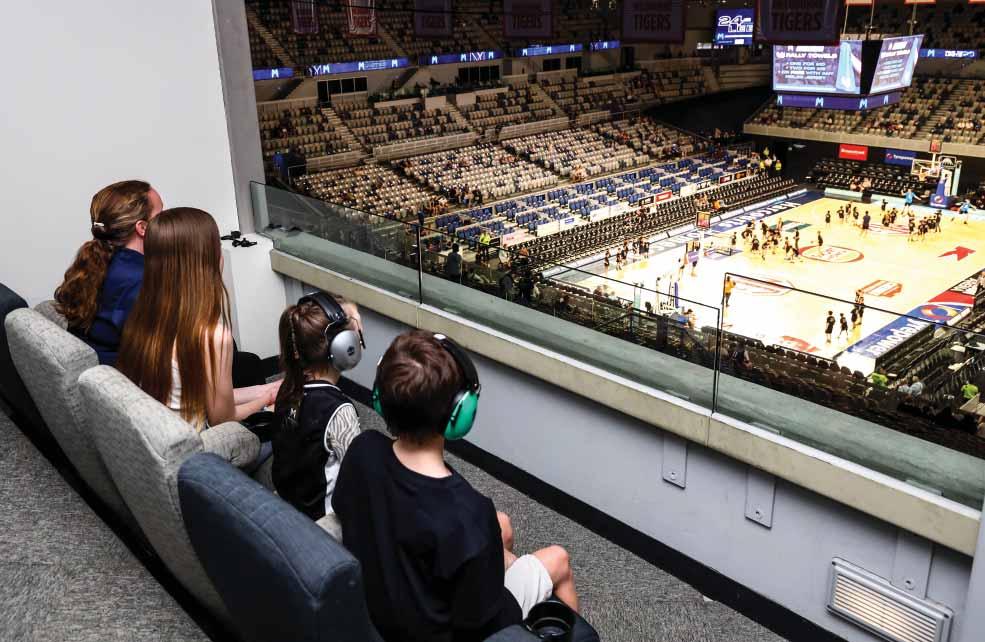
While entertainment and sporting venues offer cultural experiences for the public, they can also bring overstimulation and sensory overload to a portion of the population. Mindful of a need to be more inclusive, providers of spaces large and small across the leisure industry are adapting to offer more welcoming spaces for all.
The music, lights, cheering and clapping, the crowds - for many this is the ‘buzziness’ of events in a public space, but for some, particularly those with autism spectrum disorder, ADHD, anxiety, migraine sufferers and sensory processing disorders, this can be an enormous barrier to attendance. Not just for the individual but in some cases, their families too.
Sensory rooms are spaces specifically designed to create a quieter, calmer and soothing area for visitors who might need a sensory rest, particularly if they’re feeling overwhelmed. These retreats typically have dimmer lighting, soft furnishings and sensory-friendly décor or activities.
For the venue, it creates a bevy of benefits including a more inclusive space to attract larger visitor numbers who are more inclined to stay longer, engage more and leave with a greater sense of satisfaction.
Although these spaces are a vital part of promoting more comfortable and inclusive spaces with public leisure venues, it also raises the importance of a more comprehensive plan to truly open up these spaces to everyone, says Katie Koullas, Chief Executive and founder at Yellow Ladybugs, an Australian charity run by and for autistic girls, women, and gender-diverse folks, and their families.
The organisation collaborates with parents, carers, educators,
government bodies, and allies to acknowledge and address the unique needs of an often overlooked community. They offer support services as well as group events held in safe, inclusive environments. She says the increase in venues adopting low sensory spaces and experiences is promising.
Koullas explains “low sensory spaces provide essential quiet areas for individuals with sensory sensitivities, enabling them to engage with cultural and leisure activities more comfortably”, adding that it also goes beyond having a quiet room available.
Koullas notes “effective accessibility goes beyond physical spaces. It’s crucial that information about sensory accommodations is readily accessible and easy to understand. This includes clear signage at venues, detailed online information, and proactive communication by staff. Training staff on how to assist and interact with guests who may become dysregulated is equally important. By providing this information and training without guests having to ask for it, recognising initiatives like the sunflower lanyard, remove barriers and make our environments truly welcoming.”
The sunflower lanyard refers to the Hidden Disabilities Sunflower, an organisation dedicated to supporting people living with non-visible disabilities - anxiety, autism, dementia, PTSD, and Tourette syndrome - in their communities by raising awareness to help create a more inclusive society.
Wearing the Hidden Disabilities Sunflower discreetly indicates the wearer may require additional assistance. Lanyards are available for collection at participating venues, offering an easy-to-implement option for more inclusive and welcoming spaces.
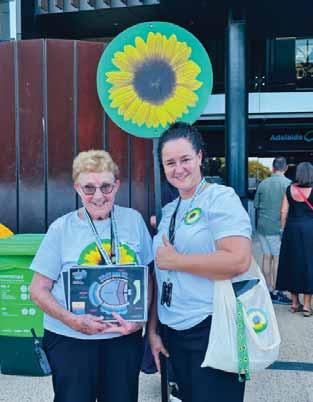
Established in 2016, the program has been adopted at a variety of airports including Melbourne, Sydney and the Gold Coast, as well as a wide range of Australian sporting and entertainment venues and clubs. Venue staff can also choose to wear a special pin or lanyard indicating they’re able and willing to provide appropriate assistance.
Venues such as the Melbourne Cricket Ground offer the option to register for a sunflower lanyard for any major event for collection before or on the event day. It additionally offers two sensory-friendly spaces for visitors to enjoy the game in quiet and calm no matter the size or energy level of the crowd. Trained staff are also available to offer assistance to visitors and their families.
The MCG and Adelaide Oval (both part of the Cultural Attractions of Australia association) also offer visitors low sensory spaces on event days.
While the MCG has created a permanent space for events, Adelaide Oval has created a sunflower path leading to a temporary space designed for the Gather Round Football Games at the venue in partnership with the Office for Autism and Novita.
This type of elevated visitor experience has also made its way to sports clubs like Melbourne United Basketball Club, who’ve included a low sensory area as a permanent part of their games at John Cain Arena, managed by Melbourne and Olympic Parks.
Laura Perett, Marketing and Content Manager for Melbourne United, advises “our purpose at Melbourne United is to use the power of basketball to enrich the lives of our community, and this includes a strong focus on inclusion and diversity.
“That’s why it was such a priority for us to launch our sensory room; to help create the most welcoming environment in Australian professional sport. We worked alongside Renae and Joe Ingles, as well as KultureCity to provide whatever our supporters need to enjoy a United basketball game in the most comfortable way possible.
“It’s been fantastic to see the room in use by our patrons whenever they need it throughout our game days at John Cain Arena.”
Likewise, Victoria’s AFL Team the Geelong Cats and Kardinia Park Stadium Trust partnered with not-for-profit organisation KultureCity to become Australia’s first accredited
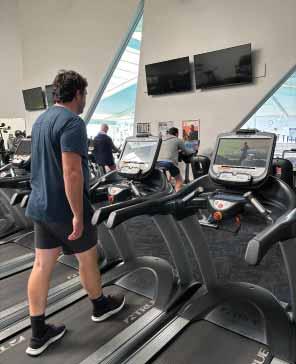
sensory inclusive stadium. The Sensory Zone was created in partnership with the Geelong Cats, Deakin University, Leisure Networks, Gateways Support Services, the NDIS and Kardinia Park Stadium Trust to create a low sensory space as well as speciality sensory bags including noise cancelling headphones, fidget toys and calming weighted lap cushions along with other helpful resources. They’ve also invested in speciality training for more than 500 staff to assist guests and improve the visitor experience.
Yellow Ladybugs’ Koullas adds “for venues that can’t include permanent low sensory space, hiring organisations to set up temporary or pop-up sensory spaces during key events can offer a viable solution. Venues can also consider holding dedicated low-sensory hours or offering early access times for those with sensory sensitivities.”
These regularly scheduled low sensory hours have been recently implemented by Belgravia Leisure at three spaces on Victoria’s Mornington Peninsula including Yawa Aquatic Centre, Pelican Park Recreation Centre and Civic Reserve Recreation Centre.
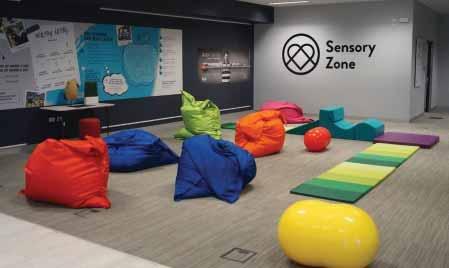


Sensory stimuli is minimised to create a quiet environment for guests with music and video screens within the health club turned off, lights dimmed and bathroom hand dryers deactivated. The program hopes to create a more accessible environment where guests with sensory sensitivities feel safe and supported and create community connectivity.
Dr Bliss Cavanagh, founder of Creative Sensory Spaces, an Australian-based organisation assisting businesses in creating these unique spaces, says there’s a significant shift in leisure spaces considering their role in creative inclusive spaces. Her research and work, drawn from personal experience of living with Tourette syndrome, has been published internationally and proves the benefits of sensory spaces. She’s worked with venues of all sizes including Sydney Cricket Ground and Allianz Stadium to create spaces “for patrons to reset, selfregulate and rejoin the event or venue.”
Dr Cavanagh states “in the past, many patrons would simply need to leave, or not feel welcome at all, so installing a sensory room has provided a strong message towards many neurodiverse patrons to feel welcome and most importantly safe to enjoy everything the venue has to offer,” she says. “We’re also seeing many organisations considering how these therapeutic spaces can better support their staff wellbeing, encouraging people back into the office and building a reputation for inclusion, accessibility and equality.”
Dr Cavanagh agrees that venues are never too small for inclusivity. Her organisation has worked with local councils and smaller venues, such as public libraries, museums and galleries to create calming spaces and pop-up experiences to support school holiday activity programs or other specialised events.
She adds that venues without capacity for a permanent room can still provide access to sensory tools to assist individuals in modulating sensory input, including noise-reducing headphones, tension-release fidget toys or calming weighted lap cushions. Additionally, venues can consider a pop-up sensory space by transforming an area just for a special event or creating options for sensory-friendly areas with low lighting or less crowding.
Creative Sensory Spaces has installed several pop-up temporary sensory spaces for events, from small community festivals to large-scale council events and concerts, including for Taylor Swift’s recent tour at Accor Stadium.
Undoubtedly the venues are seeing the benefits by attracting a more diverse range of patrons, including the families of those who may not have previously considered attending, and even further benefits of boosted ticket and concession sales too. Most importantly, it demonstrates a real, positive impact on the industry.
Gwen Luscombe is an award-winning journalist and a former recipient of the Write It Fellowship with Penguin Random House Australia. She is also a Publisher’s Australia Bell Award-winning editor.


ICC Sydney partners with Hidden Disabilities Sunflower program
International Convention Centre Sydney (ICC Sydney) has partnered with Hidden Disabilities Sunflower to use its global platform as an international event destination to promote the inclusion of people with hidden disabilities, conditions or chronic illnesses alongside hundreds of retail, travel, tourism, transport, education, healthcare, theme parks and financial institutions around the world.
ICC Sydney’s team members have grown their capacity to support people with hidden disabilities through training opportunities provided by Hidden Disabilities Sunflower.
ICC Sydney Director of Event Services, Malu Barrios notes “our partnership provides an invaluable platform for our team to strengthen their knowledge and skills in welcoming and supporting people with hidden disabilities. We’ve already implemented training on how to best communicate and support a visitor that opts to wear the sunflower lanyard while attending events at ICC Sydney.”
ICC Sydney Chief Executive and Group Director –Convention Centres, ASM Global (APAC), Geoff Donaghy said the Corporate Social Responsibility (CSR) partnership between ICC Sydney and Hidden Disabilities Sunflower will enrich the venue management team’s wellbeing and elevate its services for visitors.
Donaghy elaborated “we strive to make a difference in our community and leave a positive legacy considering the ways we can foster accessible events and better support community engagement.
“Reflecting trending delegate expectations for accessible events as identified in our RESPECT: Shaping Events for Success report and building on the development of our inaugural Disability Inclusion Action Plan, our latest partnership highlighted through our Legacy Program is another critical service provided to attendees helping them to experience the most inclusive events possible.”
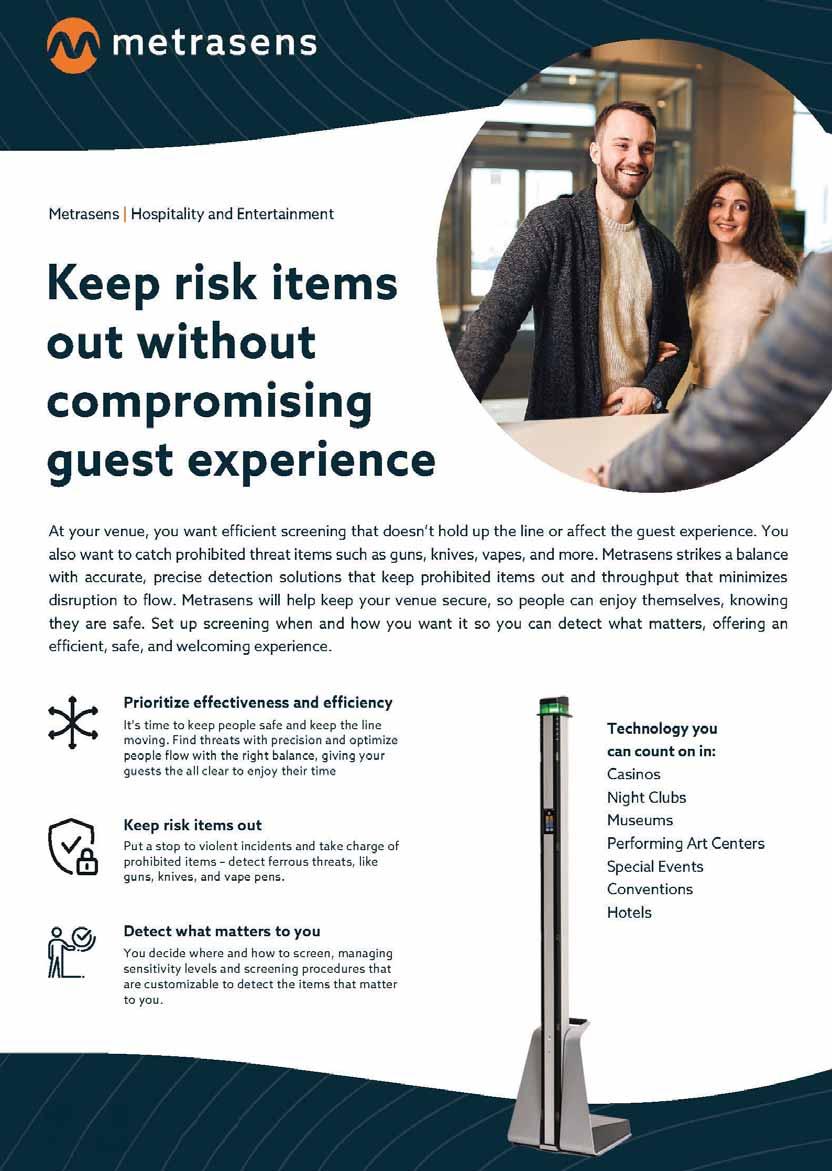
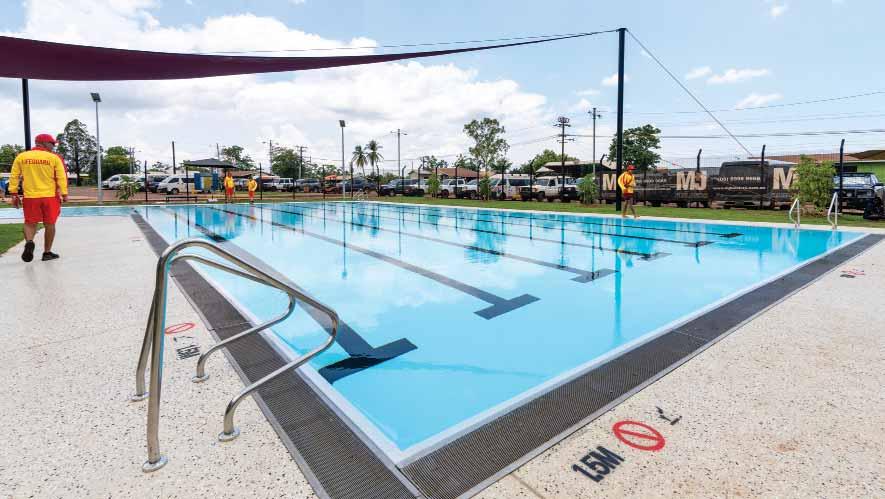


With pools in remote Australia facing distinct challenges, Karen Sweaney charts the rebirth of the Wadeye Swimming Pool
When thinking of swimming pools in Australia, people usually reference backyard pools, swimming pools in country towns and the nation’s remarkable infrastructure of major metropolitan public aquatic centres.
Yet, less obvious is the remarkable network of pools in remote and indigenous communities where, as described by a 2016 study from Royal Life Saving Society WA, they are positive enablers of community cohesion, improved health and wellbeing and higher school attendance.

Royal Life WA’s study into its Remote Aboriginal Swimming Pool (RASP) program identified a range of encouraging aspects including cultural appropriateness, community participation, positive effects on health and wellbeing, the promotion of good behaviour among youth and improved swimming ability.
In respect of water safety, the benefits of improved swimming ability are significant with Royal Life Saving Society - Australia
(RLSSA)’s 2020 report on Drowning Deaths Among Aboriginal and Torres Strait Islander People, revealing that Aboriginal and Torres Strait Islander school-aged children (aged five to 14 years) are 2.9 times more likely to drown than non-Aboriginal children.
Dotted across Northern Australia, swimming pools do face specific challenges, in relation to operating costs, attracting and retaining staff and wider community issues that sometimes include vandalism and violence.
One such facility, the Wadeye Swimming Pool in the Northern Territory’s remote west, approximately 400 kilometres from Darwin, first opened in 2003 and recently reopened having sat unused for almost half a decade.
Wadeye (pronounced ‘wod-air’) is one of the biggest Indigenous communities in the Northern Territory with a fluctuating population of around 2000 people drawn from seven language groups.
This mix of groups has, at times, led to significant unrest.
In April 2022, ongoing disputes among family groups flared into violence resulting in extensive damage to houses, hundreds of residents being forced from their homes and the death of a 33-year-old man. After these incidents, many of the residents left.
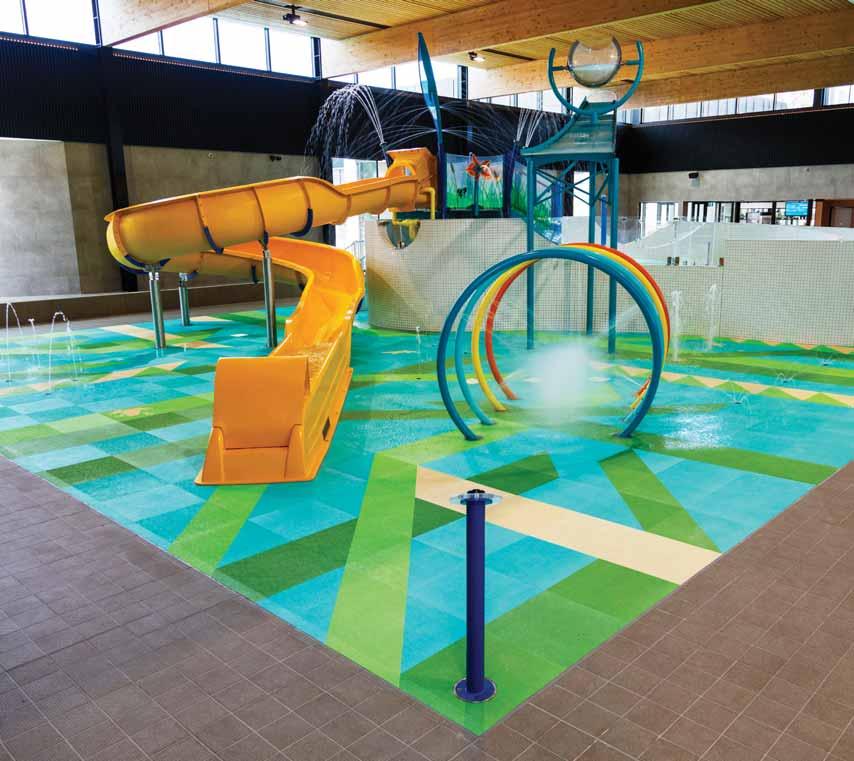
NORTHCOTE DIDN’T CHOOSE GREAT DESIGN OVER SAFETY. THEY CHOSE BOTH.


Despite Traditional owners, assisted by Northern Territory Police, working on re-establishing peace, violence also flared over the most recent Christmas period.
Prior to this the pool had been closed in 2019 following a series of challenges including attacks on staff, vandalism and increasing costs.
As reported by then operator the West Daly Regional Council in October 2019, incidents of vandalism that year included damage to the pool office, plant room and chemical storage area; toilets being smashed; recently installed pool grates and new lawnmowers being thrown into the pool; and dirt around the pool being dug up and thrown into the water.
Pool staff had also been attacked by community residents.
As a result, in 2020 Council unsuccessfully tried to offer the facility to the local catholic school - Our Lady of the Sacred Heart Thamarrurr Catholic College - to manage while also considering filling it in. With the pool closed, local children were forced to take respite from the region’s scorching summer heat by swimming in saltwater crocodile-inhabited creeks and rivers.
After the unrest of 2022, the Northern Territory Government identified reopening of the pool as a key strategic priority in improving social outcomes and the health and wellbeing of the Wadeye community, and partnered with the Council to overhaul the facility via a grant of $3 million - which rose to $4.5 millionwith the Council contributing $300,000.
Construction, by local company M&J Builders Pty Ltd, commenced in the 2023 dry season - with the pool renovation using Myrtha technology (see BOX/OPPOSITE) - and the pool reopened at the end of November last year.
To prepare for the pool’s reopening a number of Wadeye residents trained as lifeguards, in a bid to both bolster local employment and help keep users safe around water.
However, as of 23rd January, the Council advised that the pool had been closed “due to staffing issues”, taking to social media to advise “the safety and wellbeing of our community members are our top priorities, and we are taking immediate action to address this situation.”
The exception was that it was still being used in limited circumstances by students of the Thamarrurr Catholic College.
The Council’s then acting Chief Executive Mark Blackburn highlighted that under Royal Life Saving guidelines, a minimum of two lifeguards must be on duty at the pool at all timesstaffing that it had been unable to maintain.
The Council posted a further update on 5th February, seeking expressions of interest for locals interested in lifeguard training, with Blackburn telling the NT News that the Council had “struggled to recruit and train the required number of qualified staff to manage and safely operate the pool since it has reopened.”
Having failed to retain staff to operate the pool the Council then also advertised a tender for its management and operations in the “short-term”.

As of April, the Council awarded a short-term contract to The Y (YMCA) Northern Territory to operate the pool as part of its Remote Pools Project - a community led program to improve the health and vitality of First Nations communities.
As part of The Y taking over the management of the facility, registered training organisation (RTO) the Belgravia Academy was engaged to deliver lifeguard, first aid and CPR training to 22 participants, upskilling and certifying staff to allow the swimming pool to re-open its doors to the community.
Two Belgravia Academy staff, Jill Kellett from Victoria and Tanya Newsome from Queensland initially delivered online theory to the trainees, giving them time to provide extra language, literacy and numeracy support.
The pair also made their way to Wadeye to deliver in person training, covering all required knowledge in CPR, First Aid and Pool Lifeguard skills. Subsequently, Belgravia Academy has provided additional support by reviewing for management all safety and first aid equipment.
However, while the future of the facility should be assured, the Council advises that it will not be able to fund operations in the long-term. Already it has been forced to reallocate $280,000 of funds from other Wadeye projects, including the Nilinh to Wadeye footpath and Wadeye main street beautification, in order to pay for the contract.
While advocating that the pool had to be reopened to provide “much needed relief and activities for the children”, the Council is looking for the Northern Territory Government to fund its ongoing operations.
The experience of pools in remote areas being built and then shuttered, primarily over funding, staffing and safety. Indeed, since the drowning of a child in Kintore pool west of Alice Springs in December 2020, safety and maintenance concerns have closed five of the Northern Territory’s 18 remote pools.
While a pool closure in a metropolitan area would spark outrage, closures in remote Australia appear to create less of a stir, perhaps as a result of a lack of a wider recognition of their value.
RLSSA Chief Executive, Justin Scarr regrets this lack of recognition, advising “there are so many upsides to community pools in remote areas and there needs to be a collective strategy for all remote pools.
“This is not just their physical infrastructure, but also valuing their role in water safety, drowning prevention and health, and ensuring that approaches maximise employment opportunities and community benefits for adults, as well as children.
“There needs to be a Northern Territory-wide, or even whole of Northern Australia approach, in recognising this and making the most of how the best remote pools manage their resources and develop relationships with the wider community including schools, councils, health clinics and arts groups.
“However, much of this does need financial support.”
Karen Sweaney is Editor of Australasian Leisure Management.

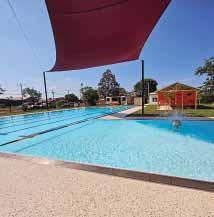
Featuring a traditional ‘L’ shaped 25 metre design used on many remote community pools with a beach entry and lap swimming area, Wadeye Swimming Pool was completed in 2003 using Myrtha Pools technology, complete with water features, a balance tank and water filtration plant.
Consisting of a five-lane swimming area which is approximately 12x25m, and a leisure area which is approximately 15x7m, it had been empty and neglected in the harsh far north Australian sun for five years before its current renovation.
With the original Myrtha technology pool walls still structurally sound after 20 years - a pre-engineered modular system, which incorporates the use of precision-engineered PVC laminated stainless steel - the pool tank was refurbished and brought to a new condition under three weeks in the most challenging environment.
The renovation introduced an Australian first, the installation of Myrtha Skin (a new PVC laminated Stainless Steel Coil technology developed by Myrtha Pools for the waterproofing of swimming pool tanks) completed by Blueprint Aquatics.
Both Myrtha Skin and RenovAction are innovative solutions to refurbish ageing swimming pools in a sustainable way. Whether an existing pool tank is leaking, losing tiles or have a poor circulation, these technologies combined will significantly reduce the time of intervention, the impact on the community and offer new warrantied and durable pool tanks compared to traditional refurbishment methods.
In addition to works in the pool tank, refurbishment was also undertaken to associated facilities, including full replacement of plant and equipment, refurbishment of the plant room, amenities block and extension of the existing shade structure, full replacement of the existing office demountable, replacement of the shade sails, installation of lighting and security systems, as well as associated landscaping.
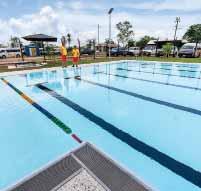
Wadeye represents a significant revolution in the refurbishment of old and ageing pools, utilising Myrtha’s skin and technologies. These innovative solutions provide reassurance to relevant authorities with a 25-year warranty and promise a remarkably short construction time, ensuring the facility is returned to the community swiftly.

Parkequip supplied the water features for the indoor Splash Park at


















































The health of Australia’s aquatics facilities is at a critical junction. With billions of dollars needed to refurbish aging infrastructure over the next decade and a wavering workforce participation rate, collective action is needed now to ensure the ongoing viability of facilities that contribute to community health and wellbeing as well as providing pathways for elite athletes.
This is not news to anyone within the aquatics industry or in local government, as skills shortages and workforce retention difficulties have continued to plague a sector that was particularly hard hit by the COVID-19 pandemic - although the main focus has been on shortages of lifeguards and swimming teachers. However, what if the key to addressing these issues is as simple as developing and supporting a national framework that standardises professional and career pathway development?
What’s at stake?
The Australian Water Safety Council (AWSC) is the voice of the country’s leading swimming and water safety organisations,

including Surf Lifesaving Australia, Swimming Australia and Royal Life Saving Society - Australia (RLSSA) and others.
Under the AWSC designation, member organisations demonstrate a commitment to water safety by directing resources toward implementation of the AWSC. The current version of the strategy (AWSS 30) aims to reduce drowning by 50% by 2030 - a goal that relies on a functioning and flourishing aquatics sector, according to research and reports from Royal Life Saving.
When the RLSSA-led National Aquatics Industry Symposium (NAIS) reconvened in 2023, it was for the first time since 2019. Uniting leaders in policy, aquatic safety, education and research, the event continued along the path set at previous symposia, focusing on improvement of swimming and water safety outcomes through development and implementation of national strategies and frameworks.
By 2023, the new realities of a post-pandemic world had become clear:
1.Gaps in swimming abilities had been exacerbated through lost time and lessons
2.Around 40% of public aquatic facilities would need major refurbishment or complete replacement within 10 years, and; 3.More than 2000 publicly accessible pools across Australia were deemed critically short-staffed.
Recognising these conditions as a threat to achieving the AWSS 30 goal, the 2023 symposium program was developed as a forum divided into three distinct topic areas: swimming skills, workforce development and infrastructure.
Understanding workforce issues
Aligning with this structure and keen to understand the status quo, Royal Life Saving worked through the National Aquatics Industry Committee (NAIC) in late 2022 to collect aquatic industry workforce information from across the country, an undertaking last conducted in 2018.









The resulting report - ‘The National Aquatics Industry Workforce Report 2023’ (NAIWR 23) - is being used to guide strategy development for the sector and to support activities designed to attract and retain key industry positions.
For context, it’s helpful to review NAIWR 23 alongside the ‘Guidelines for Safe Pool Operations’ (GSPO), as developed by RLSSA under the guidance of NAIC. Among other information, the GSPO details the qualifications, minimum skills and training needed (by occupation and region) for staff working within aquatic facilities, as well as those engaged in any formal aquatics-based programs and services - whether located within or outside of dedicated aquatic amenities.
Together, the two documents act as valuable guide, highlighting existing sector and occupational challenges while simultaneously offering insight and opportunity to help solve those issues. The Royal Life Saving recommends that details in the GSPO be adopted by all tiers of government, as well as owners and operators of facilities or locations with aquatic environments.

The NAIWR 23 found that the post-pandemic ripple effect was still being felt. The recorded national aquatics industry workforce total of 65,000 was lower than shown in the previous 2019 data collection, with an estimated shortfall of 5000 workers during the 2022/23 season.
While the workforce is clearly engaged - nearly two thirds (61%) perform more than one role within the aquatics industry, and more than a third (38%) aim to stay where they are for six or more years - the industry falls well short of GSPO recommendations for professional development, effectively limiting the prospect of progression and dampening retention rates. This is particularly true in the development of safety and key technical skills within casual or part time roles that offer a potential pathway to full time opportunities.
Based on the data, the NAIWR 23 made two recommendations under the banner of Risk, Professional Development and Career Pathways:
•In line with recommendations from Guidelines for Safe Pool Operations (GSPO), increase the availability of in-service training covering safety and key technical skills.
•Investigate, review and develop a nationally consistent workforce framework which captures and standardises approaches to professional development, reaccreditation and career development pathways for workers. This would improve retention, reduce risk, and increase quality of service provision across the national aquatic industry.
These recommendations are designed to address the skills shortfall in an industry chronically troubled by a lack of clear full-time career pathways and an over-reliance on part time and casual workers.
Aquatic technical operators (ATOs) are responsible for safely managing water quality and pool plant operations at aquatic facilities. They coordinate day-to-day operations and ensure that appropriate risk and asset management regimes are in place and being followed in line with industry standards and regulations, including the GSPO.
NAIWR 23 analysis found that ATOs are long-term industry participants. They typically arrive at an early age and via an alternate role - 42% were aged between 15-17 years. Once in the industry they tend to stay, with more than a third (35%) maintaining employment for over a decade. 32% intend to remain where they are for more than nine years.
The report shows that acquiring new knowledge and learning new skills is particularly important to this cohort, but their
TRIED, TRUE, & PROVEN FILTER
and they are made right here, in Australia.

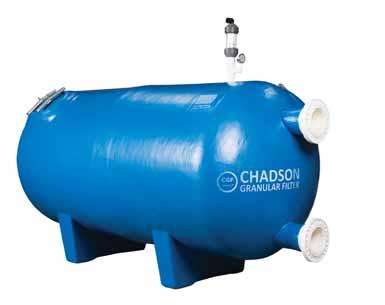
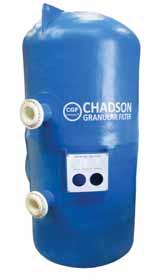




The MHS SERIES started in 1976 and is now The VSF , VDF , and VCFSERIES have The CPC SERIES The PCT SERIES



number one concern is financial support required to maintain accreditation and/or licensing. They regard emergency planning and incident management, along with problem solving and critical thinking as the two essential skills for success in an ATO role.
There is clear opportunity here for staff working in largely transient and historically difficult-to-retain roles in the aquatics industry to be transformed into a steady, long-term workforce through a program of training and upskilling that focuses on provision of clear career pathway development.
What can local government do?
Long-term investment in education obviously directly benefits aquatics facilities - including the more than 1300 public swimming pools built and owned by local government - but embedding comprehensive technical and safety skills into a professional and committed workforce also advances the industry as a whole and keeps our national water safety goals within reach.
But how can a chronically understaffed sector accelerate training and development with minimum disruption? Often compounding the problem is the ‘tyranny of distance’ - according to RLSSA, 77% of the country’s regional aquatic facilities are owned by local government - which makes participation in offsite training challenging.
Fortunately, we live in an era where comprehensive selfdirected learning is available via online delivery, enabling participants to take charge of their own training at a time - and a pace - that suits their individual needs. Using the ATO example, participants can now acquire the essential skill set required to monitor and uphold aquatic facility equipment and pool water quality, as well as coordinate the maintenance of aquatic plant

and equipment - all within the confines of their workweek and without ever needing to leave their workplace.
This innovative approach to training has transformed the learning experience, enabling students to complete necessary modules with online support from industry-trained professionals, free from the constraints of deadlines, the expenses of travel typically associated with offsite programs, and the need to take time off for in-person training sessions.
Solving the current challenges in aquatics is no simple feat. The involvement of multiple organisations, agencies and industry groups is needed to turn the ship around. For Australia to attain the goals set under AWSS 30 - and to continue our nation’s long-held love of swimming for recreation, health and wellbeing - support and promotion of our aquatics industry is vital. In developing, endorsing and participating in the roll out of a national framework that prioritises professional development, we are collectively taking the first important step.
Wendy Donaldson is General Manager of the Institute of Research & Learning (IRLearning).
IRLearning offers training programs specifically designed for the swimming pool, spa and aquatics industries, including the Aquatic Technical Operators Course. This course is designed for individuals looking to gain comprehensive expertise in the management of aquatic technical operations, encompassing the monitoring and upkeep of aquatic facility equipment, ensuring optimal pool water quality, and overseeing the seamless coordination of maintenance for aquatic plant and equipment.
IRLearning also offers tailored Aquatic Facility Training Sessions for local councils and venues that require employees to manage and maintain swimming pools and water features. Visit www.irlearning.com.au for further information.




























































































Body Bike Director Lee Smith introduces the revolutionary Body Bike Smart+ Phantom and explains how indoor cycling might just be entering a whole new era
There are few in the fitness industry as passionate as Body Bike Director Lee Smith.
The new Body Bike SMART+ Phantom is about to roll out across Australia, New Zealand and Asia Pacific. Smith articulates how the bike’s cutting-edge technology will deliver unparalleled performance with its revolutionary features set to elevate any workout experience to new heights.
Cracking the rhythm riding code
Smith explains “the new Body Bike SMART+ Phantom is the proactive stimulus that the indoor cycling segment needs.
“It’s not only the only bike designed and manufactured in Denmark but is also the only bike on the market in our regions that is made in Europe.
“Body Bike has always had a focus on sustainability with the OceanIX, the Forest Green and now Phantom all being made with recycled materials. What’s more, by 2025, every Body Bike will have its protective covers made with recycled plastic. Every flywheel, crank arm and drive wheel in every Body Bike is made from recycled steel.
“Phantom takes indoor cycling to a whole new level since it embraces all the above and caters for any and every genre of indoor cycling. Traditionally, every brand has natural strengths that make them better for certain genres but the reality for all brands is that there are then programs where they are not as strong.”
Smith goes onto explain that their cycles have always been fantastic for traditional indoor cycling and perfect for Les Mills RPM, cycling based cycle classes, Les Mills The TRIP, HIIT (High Intensity Interval Training) and programs like Les Mills SPRINT and Freestyle HIIT where the demand placed on a

bike is extremely high due to the heavy resistances to train strength and then light resistances to Sprint fast for speed.
Previously, Body Bike has not had a natural place in the rhythm riding (RR) genre where resistance is not used for outright intensity but for control. The gear ratio of cycles that do RR well are different to what Body Bike has had. For those brands that have had a place in the RR world, they suffer within the HIIT genres.
Smith advises “with Body Bike SMART+ Phantom, the new gear ratio has cracked the code.
“The perfect ratio that can do everything from HIIT cycling through to rhythm riding and everything in between.
“Our Silent Smooth Magnetic Technology creates a whisperquiet serene workout environment while our unique Quattro


Step Tension Control enables precise resistance adjustments with four distinct tension levels in every full turn of the dial, providing unparalleled control over your workout intensity.
“The new features of Body Bike SMART+ Phantom are complimented by a SMART Adjustment System which enables you to tailor your bike setup to perfection, ensuring optimal comfort and performance for every rider.”
Great For Gym Owners - Streamlining maintenance and maximising operational efficiency
Gym owners will be particularly interested in the fact that the bikes can be customised to match the theme of a studio with four solid colour options: Smart+ Black, Thunder Gray, Forest Green and Ocean Blue. A dash of colour meanwhile can be added to your studio since the Smart+ Black version has nine top cover colour options to perfectly match your aesthetic preferences and fitness space ambiance.
The custom-made Body Bike Training App meanwhile allows individuals to track and save performance metrics conveniently so that they can monitor progress and set new goals which will prove a real selling and retention point.
Perhaps the most groundbreaking feature however is the onboard tracking functionality which transforms the experience of owning and servicing a Body Bike.
This innovative addition provides unparalleled insight into the bike’s performance, catering to both club managers and authorised service personnel alike. Club managers gain access to comprehensive data, allowing them to monitor operation time, distance, average watt, and meticulously track past history.
Moreover, authorised service personnel can effortlessly register replaced spare parts, with the bike seamlessly logging the date and distance automatically.
Smith notes “this aspect is massively important for gym owners as it not only provides an advanced tracking system but streamlines maintenance and maximises operational efficiency.

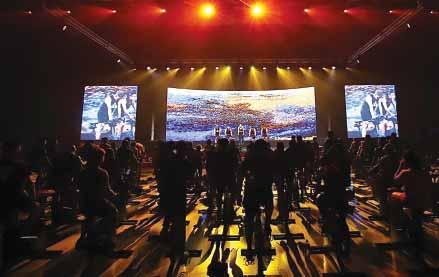
It sets whole new standards in fitness equipment management and promises to have a massive impact on the bottom line.”
It was important to Body Bike that the development of the Phantom had a strong focus on sustainability. Recycled materials were used to ensure a low carbon footprint without compromising quality or performance. There was also an objective to ensure the latest technology advances were integrated during development.
A charging functionality ensures you stay connected and motivated while Bluetooth and ANT+ Connectivity enables you to seamlessly connect to your favourite devices and fitness apps and expand your workout options.
A lifetime warranty on the pedal arm, demonstrates Body Bike’s commitment to quality craftsmanship. Extended bar ends provide additional support and stability during intense workouts while integrated wheels, enhance convenience and portability.
The Company - active in Australasia for over 17 years
In 2023, Body Bike Asia Pacific was created with a focus to stimulate sales within the APAC region. While in Asia there is a strong Les Mills presence, there is also a larger boutique cycle segment.
Last year, also saw Body Bike chosen as the bike to be used for the Les Mills RPM programs 100th release after which, in January 2024, 95 new Body Bike SMART+ cycles were installed in the Les Mills Victoria Street Auckland City gym’s Cycle Studio - a development that sees the bike being enjoyed by every club member as well as being seen in every Les Mills RPM, SPRINT and The TRIP filming going forward.
The filming, done four times per year, is content for instructor learning, virtual class content and LM+ home user content.
Smith, along with his fellow Body Bike Asia Pacific Director Paul Hillbrick, both come from metal trade, engineering and cycling backgrounds with Hillbrick still being a bicycle frame builder who handmakes custom frames. They have both raced competitively in the past and still ride socially today.
Smith’s personal history in the indoor cycling space has seen him work for Les Mills in many capacities. He became a Les Mills RPM instructor in 2006. By 2008 he was elected to become a part of the local Les Mills Asia Pacific Trainer and Presenter team and in 2010 he was selected to be involved in the filming of an RPM quarterly release in New Zealand and that began a seven-year journey working for Les Mills International. He has been involved in the development of Les Mills SPRINT, and has worked extensively with Les Mills Asia Pacific where he looked after licensed partners across Western Australia and the Northern Territory.
In December 2023, Smith stepped back into Body Bike Asia Pacific in a full time capacity to point the company in the best direction with a new entity and new products coming to

market. Smith makes a point that the company are the ultimate specialist, adding “we know our products. We are passionate about the best bikes. We know our segment and what makes a great studio. What makes the best instructors. What makes the best classes. We understand our customers and we have a very high return business percentage.
“Business who purchase Body Bike return years later to buy Body Bike again. Our return business sits at 96%. We are very good at this.”
Australasian Leisure Management’s James Croll was speaking with Lee Smith, Director at Body Bike Asia Pacific.
Further details about the Body Bike+ Phantom and Body Bike Asia Pacific can be obtained contacting Lee Smith on lsmith@bbike.com.au or 0488 090 904.
Silent Smooth Magnetic Technology: Whisper-quiet operation with magnetic technology, ensuring a serene workout environment.
Quattro Step Tension Control: Precise resistance adjustments with four distinct tension levels.
New Gear Ratio: Catering to a range of exercise styles, from high-intensity intervals to endurance rides and dance-inspired sessions.
SMART Adjustment System: Tailored bike setup function to ensure optimal comfort and performance.
Unique Tracking: Service and Maintenance monitoring functions guaranteeing optimal bike performance and longevity.
Studio Theme Matching: Four solid colour options plus nine top cover colour options allow aesthetic preferences and fitness space ambiance.
Body Bike App: Track and save performance metrics to monitor progress and set new goals.
Recycled materials | Low carbon footprint: Focus on recycled materials, minimising carbon footprint without compromising quality or performance.
Technology: Integrated phone charging, Bluetooth and ANT+ Connectivity.
Peace of Mind: Lifetime warranty on the pedal arm.
Extended Bar ends: Additional support and stability during intense workouts.
Integrated Wheels: Designed to enhance convenience and portability.
















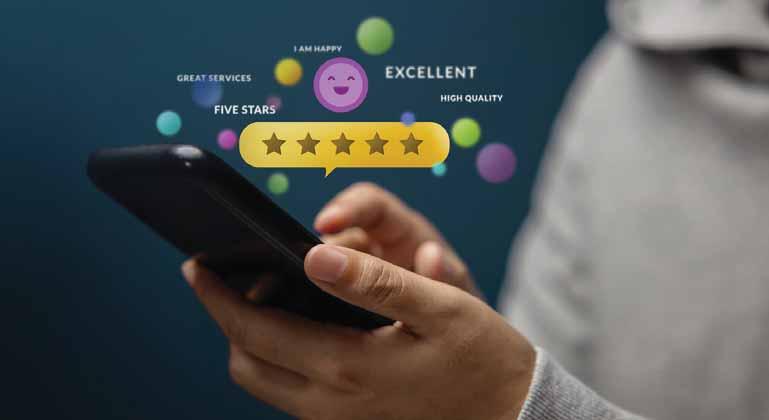
In the highly competitive fitness industry, the emphasis on member experience and care has never been more critical and, as many readers will be aware, recent fitness business conferences have witnessed discussions and presentations about the need to enhance the member experience threaded throughout the agendas.
In this, the first of an ongoing series of features I’ll explore how aquatic, fitness, recreation and wellness businesses can not only meet but exceed the modern consumer’s expectations, setting the stage for unparalleled success in an environment where it is getting harder and harder to differentiate ourselves. This article aims to unravel the complexities of member engagement, highlighting the transformative power of personalised service and the pivotal role of technologies like AFFINITY OS™, PH360™, and MyZone™ in crafting memorable fitness and wellness journeys.
Understanding and meeting the expectations of modern consumers has become crucial for businesses aiming for sustainability and growth. Today’s fitness consumers are not just looking for a place to work out; they are seeking a comprehensive wellness experience that aligns with their personal values, lifestyle, and technological savviness. The digital transformation sweeping across all sectors has significantly influenced member behaviour and preferences, reshaping the way fitness and wellness businesses must operate to stay relevant and competitive.
Today’s fitness consumers are more informed, connected, and discerning than ever before. Their expectations extend beyond traditional workout regimes to include an holistic approach to wellness that encompasses physical, mental, and emotional health. How we communicate with these consumers is also
changing. Gen Z consumers are picking up the phone and boomers are comfortable chatting online. Key expectations are morphing with some of these including:
•Personalisation: Members expect fitness programs and wellness services that are tailored to their individual goals, preferences, and health needs. This personalised approach ensures that they receive the most effective and enjoyable experience possible. This is hard to scale if you aren’t able to leverage technology.
•Convenience and Flexibility: In a fast-paced world, convenience is king. Modern consumers expect the flexibility to access fitness and wellness services on their terms, whether that means 24/7 gym access, on-demand virtual classes, or mobile apps that allow them to manage their fitness journey from anywhere.
•Technology Integration: With the proliferation of wearable devices and health apps, members expect fitness and wellness businesses to seamlessly integrate with their digital ecosystem, providing data-driven insights and recommendations to enhance their health and fitness journey. Application Programming Interfaces (APIs) are now the norm allowing savvy platforms to connect and interface with other technologies to optimise the member experience.
•Community and Connection: Beyond individual goals, modern consumers look for a sense of community and belonging. They value businesses that foster social connections, offer group classes and programs, and create an inclusive environment where members can support and motivate each other. As much as the modern consumer embraces the online world, nothing comes close to the power of real world connections and community.
•Sustainability and Ethical Practices: There is a growing expectation for businesses to operate sustainably and ethically, reflecting a broader societal shift towards environmental consciousness and social responsibility. As transparency grows this becomes more than a ‘box to tick’.

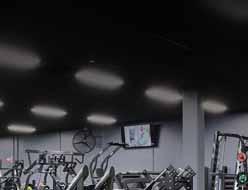




Requirements
•Min 500 members
•Min 400m2 premises
•Profitable over the previous 24-36 months
•Opportunity to grow
•Multi-club operations (desirable but not essential)
•Will consider franchised locations if the franchise can be terminated

The digital transformation has been a game-changer in the fitness and wellness industry, influencing member behaviour and preferences in several ways:
•Increased Demand for Digital Services: The rise of digital platforms and services has led to an increased demand for online fitness classes, virtual personal training, digital health tracking and personalised fitness and nutrition programs. Members now expect a hybrid model that combines the best of in-person and digital experiences.
•Data-Driven Decisions: With access to a wealth of data from wearable devices, fitness and nutrition apps, members are making more informed decisions about their health and fitness routines. This data-driven approach has raised expectations for personalised and adaptive fitness programs.
•Elevated Experience Expectations: The convenience and personalisation offered by digital technologies have elevated member expectations for all aspects of the fitness and wellness experience. Businesses must now provide a seamless, highquality experience both online and offline to meet these heightened expectations.
•Shift Towards Wellness Communities: Digital platforms have enabled the creation of virtual fitness and wellness communities, where members can find support, motivation, and accountability. This shift emphasises the importance of community-building both within and outside the physical premises of fitness businesses.
In the evolving landscape of fitness and wellness industries, technology has become a cornerstone for fostering personalised and engaging member experiences. Fitness and wellness businesses are increasingly leveraging innovative tools and platforms to not only meet but exceed the expectations of their members.


AI-driven technology is reshaping the way fitness and wellness services are delivered, ensuring that member engagement is personalised, efficient, and deeply satisfying. These range from ph360, a lifestyle platform that uses AI and biological sciences to provide personalised health and wellness guidance, to advanced member experience platforms like AFFINITY OS that provide operators with real time, actionable insights into their members experience.
Wearable devices have revolutionised the fitness and wellness industry by enabling personalised health monitoring and fitness tracking. These devices, ranging from smartwatches to fitness bands, collect data on an individual’s physical activities, heart rate, sleep patterns, and more.
This data empowers both members and fitness coaches to tailor fitness programs that align perfectly with the individual’s health status and fitness goals, making every fitness journey uniquely personal and significantly more effective.
Mobile applications have become indispensable in enhancing member experiences in fitness and wellness businesses. We all have super computers literally in our hands and the plethora of available apps serve as a one-stop solution for members to book classes, access workout plans, track progress, and even receive personalised plans. The convenience of having such tools at members fingertips boosts member engagement and retention, as they can seamlessly integrate their fitness routines into their daily lives. For example, the ph360 app offers continuous, personalised health guidance ensuring the users wellness plan aligns with their evolving needs.
At the forefront of technological innovation in member engagement is AFFINITY OS, a powerful AI-driven customer experience and team member engagement platform. AFFINITY OS stands out by offering predictive insights into member and team member preferences and behaviours, enabling businesses to anticipate and cater to needs before they are explicitly expressed. This proactive approach to team member engagement and member experience fosters a deep sense of belonging and satisfaction among both constituencies, as they feel understood, valued and communicated with at a personal level.
Virtual reality (VR) technology is introducing an entirely new dimension to fitness and wellness experiences. By immersing members in virtual environments, VR enables them to engage in physical activities that are both fun and effective. From virtual bike rides through scenic landscapes to yoga classes on tranquil beaches, VR makes working out an exciting adventure,
ENGAGEMENT AND MOTIVATION
Biofeedback and AI for real time guidance

BIODRIVE SYSTEM PATENTED
NEUROMUSCULAR ACTIVATION
Increased neuromuscular activation
PERSONALISED ROM
CORRECT POSTURE Right ROM and speed
OPTIMAL WORKLOAD
Maximum muscle contraction Automatic posture setup
Biostrength™ helps you avoid the most common strength training mistakes to get up to 30% more results from your workout.
Thanks to the patented Biodrive System, you can easily and automatically:
Select the goal and get the best resistances and biofeedback for it
Train with the correct workload
Find the proper range of motion
Set the right tempo and number of reps
Get the correct rest time
Discover more on technogym.com/ALM

significantly enhancing member engagement and motivation. An example is Supernatural, a popular VR fitness app that offers workouts with beautiful global locations, popular music, and energetic trainers.
Social platforms play a crucial role in building communities around fitness and wellness businesses. These platforms offer spaces for members to share their journeys, celebrate achievements, and find support among peers. The sense of community fostered through these platforms enhances member loyalty and creates a positive, inclusive environment that extends beyond the physical boundaries of the club.
Personalised interactions and services create a sense of belonging and value among members, making them feel recognised and understood as individuals with unique fitness journeys. This can lead to increased member engagement, retention, and word-of-mouth referrals, which are invaluable in today’s competitive landscape. Key aspects of personalisation in fitness and wellness clubs include:
•Customised Fitness Plans: Developing fitness plans that cater to the specific goals, abilities, and preferences of each member. This could involve personalised workout schedules, one-on-one coaching, and adaptive fitness programs that evolve with the member’s progress. Coach Welly is an example, coming to market in 2024, that offers an AI-driven wellness coach experience.
•Personal Touchpoints: Ensuring that all interactions, from the front desk to the fitness floor, are personalised. This could include recognising members’ achievements, addressing them by name, and being aware of their preferences and dislikes. Staying abreast of evolving member preferences is tough, and platforms like AFFINITY OS manage that challenging task by consistently sampling active members and when they give feedback there is a simple response system that allows the club to interact with the member in a personalised manner.
•Technology-Enabled Personalisation: Utilising technology such as fitness apps and wearable devices to track progress, adjust fitness plans in real-time, and provide personalised feedback and encouragement. Examples like MyZone enhance fitness routines by providing personalised heart rate monitoring through wearable devices. MyZone’s gamified approach,
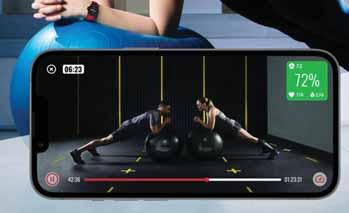

combined with a supportive social platform, motivates members to achieve their fitness goals by fostering a sense of community and personal engagement.

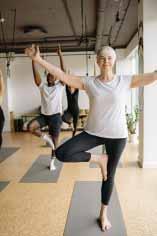
•Nutrition Advice: Offering personalised nutrition advice that complements the fitness regime of each member, taking into account their dietary preferences, restrictions, and nutritional needs is complex. Ph360 does a masterful job of this complex space. Ph360 uses AI and data from the members body to tailor aspects of a members lifestyle. A network of coaches support the member’s aspirations and even help members find new friends and connect with people who think the same way that they do.
•Recovery and Wellness Services: Including personalised recovery plans that use information from workout sessions to suggest specific recovery techniques, such as massage, sauna, or specialised classes like yoga or Pilates, tailored to the member’s current fitness level and recovery needs. Most online interfaces are providing HRV or ‘Readiness’ scores for exercisers to manage their recovery and activity.
As technology becomes more and more ubiquitous in the fitness, wellness and leisure spaces it is important not to look at these tools as competition or niceties. Whether we like it or not, we need to leverage the technological advancements that are happening around us. And this is just a sampling of the vast array of tools and opportunities that are available to personalise and enhance the members’ experience.
Grant Gamble has over 30 years of experience in leading teams to create innovative customer experiences, building engaged workforces, and developing leaders who prioritise mindfulness in their approach.
His book, The Affinity Principle™ presents a formula for business success through a people-centric, mindful leadership approach. Most recently, he has served as the Chief Executive of TotalFusion Australia, the largest health and wellness campus in the Asia-Pacific.
In the next article in this series the author will further explore the impact of community building in driving club loyalty, retention and referrals.
11-12 OCTOBER 2024
ICC SYDNEY
• What’s new and what’s next in health & fitness
• The latest equipment & tech
• World class education
• Connect with thousands of buyers, gym owners, managers and fitness professionals under one roof


Chris Skinner, Managing Director of HF Industries, has a formidable reputation for protecting the integrity of Balanced Body Pilates equipment. Nigel Benton explores the lengths to which he will go to protect the brand’s copyright
There’s a saying that to be copied is the highest form of flattery but in today’s world of intellectual property, copyright, counterfeits, fraud, fakes, copies, scams and rip offs it can be so difficult to determine what is real and what is not.
In the world of Pilates, it’s a certainty that anyone offering or operating true Balanced Body reformers and related equipment in Australia, is providing the authentic brand.
The reason? As the Australian and New Zealand distributor of Balanced Body products, Chris Skinner, Managing Director of HF Industries will enforce the brand’s IP by all possible legal means.
Every piece of Balanced Body product worldwide has its own serial number. If it doesn’t then its not a Balanced Body product.
With Pilates having a more than century long history - a heritage Australasian Leisure Management celebrated in a series of articles in 2020 - over recent years, the movement has grown into a global exercise and wellness phenomenon in the past few decades, and particularly since the pandemic.
In September 2020, fitness technology platform Mindbody revealed that Pilates (along with strength training and yoga) were the most popular exercise classes that consumers wanted to undertake upon returning to facilities in Australia, while in November 2022, business publication Forbes revealed that Pilates was the fastest-growing exercise genre in Australia and New Zealand, experiencing 250% growth in the 12 months to September 2022 - more than 2.8 times that of the next-best genre.
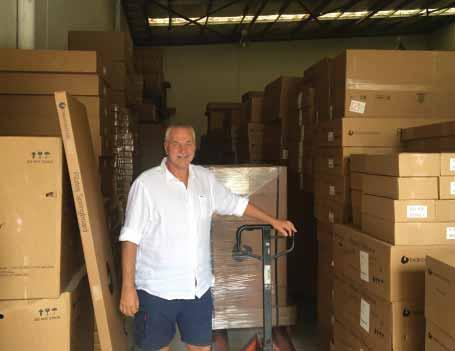
On top of significant in-home use, Pilates reformers are being offered through physiotherapists, independent studios, franchises - several of whom such as Upstate Studios, KX Pilates, Core Plus and Love Athletica have been highly successful - and fitness clubs and aquatic and recreation centres.
With this growth has come demand for Pilates equipment which, exaggerated by pandemic shipping issues, has sometimes outstripped supply.




Join us at Ignite Fitness Business Events for a transformative experience that will propel your success to new heights. Discover cutting-edge strategies, connect with industry leaders, and unlock your path to greatness.










Friday, 2 August 2024 9am - 4pm
Expert Insights
Learn from top industry experts and gain invaluable insights to elevate your business strategy.
Actionable Strategies
Discover practical, actionable strategies that you can implement immediately to drive growth and
Don’t miss out – register now at and use code ALM for 10% off your ticket.







Saturday, 3 August 2024 9am - 3pm
Networking Hub
Connect with like-minded professionals and expand your network for future collaborations and partnerships.
Be inspired by our lineup of dynamic speakers who will share their stories and wisdom to motivate and energise you.









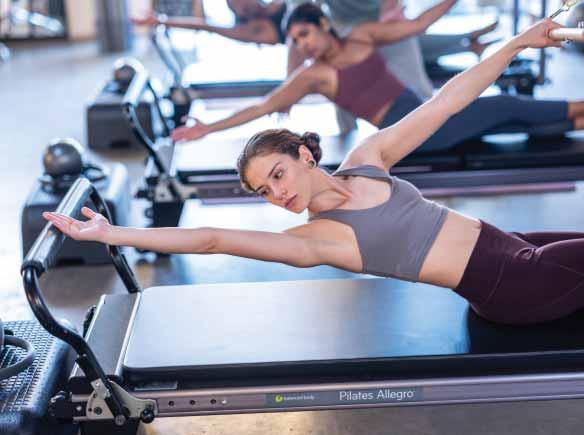
As a supplier of Balanced Body equipment since 1996, Chris Skinner has been instrumental in its growth.
However, he explains “as a distributor it’s not about just selling a product - you must not only supply and support the equipment, but also show people how to make money.
“What’s been established with Reformers is how versatile Pilates is with its traditional usage and as used in group exercise. Group exercise with a Pilates Reformer machine is the reason why we now have groups that are doing 40, 50, 60 some doing 80 classes a week.
“The Reformer has the greatest return of investment that you are ever going to find in a fitness exercise product.
“It’s very simple to work out, for the amount of money that you outlay for one of our Reformers you will get a maximum return as opposed to any other piece of equipment. If you are doing an average of 40 classes a week over 45 weeks and you’re charging $20, $25 a class and you’ve got 15 machines on your floor, you’re getting an annual return of somewhere between $36,000 to $45,000 per machine.
“Across those 15 machines, you’re making more than $500,000 a year.
“That’s the reason why the Pilates market is so successful here, and the reason why others feel the need to copy.
“At the same time, our product would offer the strongest return for one’s investment. For example, a Balanced Body A2 Reformer - which is the most copied - purchased 10 years ago, would sell today in the marketplace for what it was purchased for back then.
“So they’re getting a 100% of their money back 10 years down the track. Why? Because of the quality, they know they can still come and get the parts. They can still get the upholstery, they can still get the ropes, they can still get the shoulder pads, simply by quoting their serial number from each unit.”
“And that’s why those that copy feel the need to use our identity to capture some market share.”
As a result, Skinner highlights that while in the USA Balanced Body has just a handful of competitors; in Australia there are more than a dozen suppliers in the marketplace, with products even being sold through Bunnings.
However, while some are legitimate, others deal in counterfeit products.
With this success, Balanced Body has encountered a number of imitators. As innovative manufacturers in many nations know all too well, their innovations are often copied.
As Skinner explains “we encounter direct copies of Balanced Body products - even down to trademarks and branding, that are illegally imported into this country, sometimes by suppliers

importing multiple items and also for use in a single location - using our name, our images and our materials in their promotions.
With suppliers, Skinner notes “they import the machine, hold them in a warehouse and get instructors to go and sell them to people and advertise through different media as Balanced Body product, generally about a thousand dollars under our price. We’ve got to know who a lot of them are by their boxing and various other means.
“They’re the easy ones to make phone calls to, advising them of our position, how we protect Balanced Body’s patents and what they need to do.
“But with individual facilities, many have come to us and got a price and then think of how they can get a competitive edge over the rest of the marketplace and go and buy a copy, not wanting to pay the price that we charge.
“In some cases, they know they are buying copies, but some of them actually think that they’re buying Balanced Body product at a cheaper price.”
As for discovering the copies, Skinner and his team look online every day for products that infringe.
In addition, he states “a lot of discovery comes to us when someone has purchased a copy and they think that it’s ours and it’s broken down - or they can’t find who sold it to them in the first place - and they then need some service.
“When they ring up, we ask ‘what’s the serial number?’, they say there isn’t one, so we ask them to send us a photo of the equipment, after which we go back to the inquirer and say ‘you’ve bought a product which is illegal, you’ve bought a product which has been copied, you do not have Balanced Body product.
“We have no problem with competing against other companies that don’t copy our product, don’t use our name, don’t copy our IP, but those that do, we go after.




“We’ve had those who have ‘lawyered up’ - which ends up costing them considerably more, we have had those that want to negotiate, saying ‘we will buy Balanced Body at our next location if we can keep these’ and we have people that say they didn’t realise the product was counterfeit.
“But it’s pretty simple.
“We don’t ever discount our product.
“We don’t show favouritism to any particular company.
“We supply many of the major fitness and wellness groups and they are all on an equal playing field as far as we are concerned.
“We provide them with different variations and different machines in our range to suit their purposes.
“But to have someone down the road from them who has purchased an illegal product, who promotes themselves as a facility with Balanced Body product, then uses our pictures, our name to try and attract business - that takes business away from the people that have actually come to us and purchased our product.
“We feel we have justification to stop the copies and protect our clients, because our clients are our future and our clients come back and continue to buy from us when they open new studios and facilities.
“They expect us to provide them with service, support and the backing that we’ve given for 46 years.”
While Balanced Body protects its patents around the world, Australia is at the forefront of the brand’s efforts in relation to combatting counterfeiting.
The reason is, unlike many other nations, Australia’s love of group exercise.
Skinner explains “while the number one exercise worldwide is dance, the number one exercise in Australia is Pilates reformer classes. That’s where it’s at. America is starting to catch up. Europe is starting to catch up. We have inquiries coming through our website every day from all over Europe, Singapore, Taiwan are taking off and Korea is strong, but not so in the actual commercial fitness market.”
When HF Industries discovers copy Balanced Body equipment, Skinner explains “what we do - depending on where it is - is to notify them they are infringing with illegal product. We ask when they bought the item and who they bought it from. We require them to take down any reference to Balanced Body in the marketing and promotional material.
“Some people are upfront, and forward us the information, while some people try and throw spanners in the works.
“However, in all cases we pursue the buyer, take the counterfeit products away and destroy them.”

The whole machine is then destroyed.
“From there it’s the buyers choice, they can either come and buy purchase from us and get the proper product, or they can go and buy from one of our competitors - and there’s some good competition out there - but they can’t buy product that infringes on what we have as protected.
“As we check our systems, we find that 90% of these enquiries, at some point had come to us and got a pricing, which would suggest they knew exactly what you were doing.
“You went and bought someone else’s product and whether you knew that it was a fake, infringing or whether you didn’t,the simple fact is it’s illegal in this country. You can’t purchase that product. That product isn’t allowed to be brought in.
“So, we need to go after the people that brought it in, the people that manufactured it, which means yes, we go into countries like China who have copied our products.
“We go after them and whatever they’ve brought into Australia and New Zealand and take the product out of the market.
“Some people who have bought the copied product say they’ve sold it on or say, ‘we’re going to give it away to our instructors’. Well, that again is illegal they can’t give it away to anyone and they can’t sell it to anyone.
“There are only two areas for us.
“One, our protection and two our client’s protection.
“The people that have spent the money and paid to get our product deserve to be supported. They are the ones being ripped off.
“Competition is one thing, stealing and using another’s identity to try and gain an advantage, needs to be stamped out.”
Skinner concludes “those that purchase such copies, they are the ones that are going to lose most.
“They are the ones who have been conned, who will lose at least twice and possible everything.
“My best advice, if you are looking for Balanced Body product, look for a serial number. If it’s not being offered by HF Industries or if the serial number is not there, it’s not Balanced Body and if you do buy something else, please do not use our name or images.” ALM
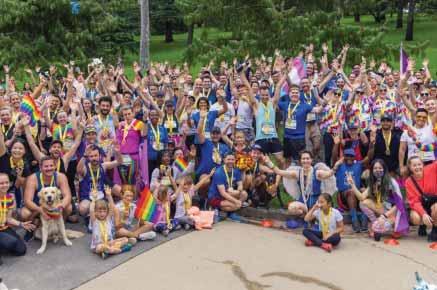
Em Fox explains how the Rainbow Ready program is promoting inclusivity in Australian sport
In Australia, the pursuit of bringing sport, fitness, activity and movement all together is deeply ingrained in the national culture. However, for members of the LGBTIQ+ community, accessing these domains has often been accompanied by significant barriers. Discrimination, prejudice, and lack of understanding have historically alienated many from fully participating in sports and leisure activities. Recognising this issue, initiatives like the ‘Rainbow Ready’ programs, spearheaded by organisations such as Proud2Play, are striving to dismantle these barriers and foster an inclusive environment for all.
For individuals within the LGBTIQ+ community, the sport, active leisure and movement world has frequently been a hostile environment. Discrimination and prejudice have manifested in various forms, ranging from overt acts of bigotry to subtle forms of exclusion and microaggressions. These experiences can lead to feelings of isolation and reluctance to engage in sports and fitness activities.
One significant barrier is the pervasive presence of heteronormativity in Australian culture. Traditional gender norms and stereotypes often dictate the expectations placed on people that wish to get active in our leisure spaces, creating a culture that may be unwelcoming or intolerant of those who do not conform to these norms. This can result in LGBTIQ+ individuals feeling pressured to conceal their identities or modify their behaviour to fit in, detracting from the enjoyment and inclusivity of participation.
Moreover, institutionalised discrimination, such as policies and practices that exclude transgender and gender diverse individuals from participating in sport and movement aligned with their gender identity, further exacerbates these challenges. Fear of harassment, ridicule, or unfair treatment can deter many from engaging in movement altogether, depriving them of the


physical, mental and social benefits that participation offers. How do we ensure that the young gay man feels welcomed to bring his partner to the gym, or the elderly transwoman can access an aquatic facility to do their rehabilitation after knee surgery, or the teenager exploring their gender isn’t policed by other patrons out of the changerooms?
Proud2Play have developed innovative initiatives such as the Rainbow Ready programs in response to these barriers, with one program specifically dedicated to the leisure industry. These programs are designed to create safe, supportive, and inclusive spaces within sport and leisure, ensuring that individuals of all sexual orientations, gender identities, and expressions can participate free from discrimination or prejudice.
Rainbow Ready programs encompass a range of activities and interventions aimed at promoting awareness, education, and cultural change within sports and leisure organisations. Workshops, training sessions, and resources are provided to staff, management, administrators, trainers and coaches, and even patrons to increase their understanding of LGBTIQ+ issues and equip them with the skills to create inclusive environments.
One key aspect of Rainbow Ready programs is the emphasis on community engagement and partnership building. By collaborating with local LGBTIQ+ organisations, sports clubs, community groups, and local councils, these programs foster networks of support and solidarity, empowering individuals to advocate for change within their own communities.
Participating in Rainbow Ready programs offers numerous benefits for sports and leisure centres, extending beyond mere compliance with anti-discrimination laws. Firstly, embracing inclusivity enhances the centre’s reputation as a welcoming
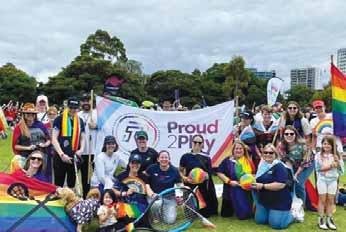
and progressive establishment, attracting a broader and more diverse clientele. This can lead to increased membership, participation, and revenue streams, as individuals feel comfortable and valued within the facility.
Moreover, Rainbow Ready programs contribute to a positive organisational culture characterised by respect, empathy, and diversity. By educating staff and stakeholders about LGBTIQ+ issues, these programs foster a culture of understanding and acceptance, reducing the likelihood of discriminatory incidents and creating a supportive environment for all.
Additionally, embracing inclusivity aligns with broader social and ethical values, demonstrating the centre’s commitment to equality and social justice. This can enhance the centre’s brand image and appeal to socially conscious consumers who prioritise patronising businesses that uphold inclusive practices and values.
Furthermore, by actively engaging with the LGBTIQ+ community and participating in Rainbow Ready initiatives, sports and leisure centres have the opportunity to contribute to broader societal change. By serving as agents of progress and inclusion, these centres can help challenge entrenched prejudices and stereotypes, fostering a more equitable and inclusive society for all.
Facilities following the Rainbow Roadmap
In inner eastern Melbourne, the Y Boroondara have begun their own journey with the Rainbow Roadmap, the key component of the Rainbow Ready program. With three major sites in Balwyn North, Hawthorn and Ashburton, these facilities create an opportunity for the 165,000 residents of Boroondara to access safe welcoming spaces to connect and stay healthy. Having undertaken audits of their facilities from an inclusion perspective, explored policies, and engaged in interviews with team members from many different roles across the organisation, the Y Boroondara are now ready to move into the second and third stages of the Rainbow Ready Program. Em Fox is Capacity Building Officer at Proud2Play.


More than half of LGBTIQA+ young people in Australia have witnessed discrimination in community-based sport, according to a new Swinburne University of Technology study.
Led by Swinburne Research Fellows Dr Ryan Storr and Dr Carleigh Yeomans, the landmark study of over 1,000 LGBTIQA+ people across Australia - the largest of its kind in a decade - reveals that LGBTIQA+ young people’s (1625) participation rates are significantly lower (around 30%) compared to non-LGBTIQA+ peers (60%).
40% of this group reported personal experiences of discrimination, primarily through verbal vilification.
While there have been improvements over the past decade, progress has been slow and stubborn, particularly for young gay men, 76% of whom reported witnessing homophobia, with 63% experiencing it firsthand.
Overall, 53% of LGBTIQA+ young people surveyed witnessed discrimination in sport and movement settings.
Explaining that the report points to the need for sustained and targeted efforts to make sporting environments safe and inclusive for all players, Dr Storr stated “the young people we spoke to for this study highlighted their desire to be able to play sport and ‘just exist’ or be themselves, without having their identities questioned, debated and interrogated.”
The research, which was supported by an Impact Research Grant from health promotion foundation VicHealth, highlights the urgent need for tailored programs and initiatives to address homophobia and foster safe and inclusive sporting environments - especially in youth environments.
Dr Storr noted “while the data reveals promising trends across the broader LGBTIQA+ community, the reality is that LGBTIQA+ people have a fifty-fifty chance of witnessing homophobia when they play sports.”
Dr Storr found that LGBTIQA+ youth still encounter multifaceted challenges in navigating their identities within sport and movement spaces, including concerns about whether to disclose their identities to teammates and coaches, assessing the safety of club environments, and managing their mental health amid pervasive discrimination.
He went on to say “sustained and targeted efforts are needed to make sporting environments safe and inclusive for all players, with anti-homophobia campaigns and initiatives urgently needed. The major sporting codes must commit to taking immediate action in tackling LGBTIQA+ discrimination, especially across men’s team sport environments.”
For organisations wanting to take action, Dr Storr suggests participating in Proud2Play and VicSport’s ‘Rainbow Roadmap’ program, which supports clubs and organisations in becoming Rainbow Ready.

In an Olympic year when it should be expected to reap the benefits from the sport’s expected high exposure, Australian gymnastics is currently experiencing internal turmoil with grassroots clubs at odds with its governing bodies.
The situation is such that facing escalating costs and a fragmented approach to governance, community clubs are considering ending their affiliations with Gymnastics Australia and their respective state sporting organisations bodies.
As a result, clubs have seen their young gymnasts barred from competing in various levels of competitions - including the recent national championships on the Gold Coast.
Describing this conflict, Andy Bassett, owner of Focus Gymnastics in Dubbo and with two decades of experience in

the sport, told the Code Sports website in May that “they are weaponising the children against clubs.”
Alongside Michelle Keeffe, owner of Active Gymnastics in Perth, Bassett estimates that more than 90 grassroots clubs have either ended or are considering ending their affiliation with state and national bodies due to dissatisfaction with the current system, blaming the fragmented approach of the respective state bodies, duplication of services and the fees that clubs are required to pay.
Collectively, Bassett and Keeffe blame layers of administration and the sport’s federated model of governance, where state bodies elect the majority of the national board, effectively controlling its strategic direction.
Underpinning Australia’s system of sport governance, the federated model, which has not changed significantly in over 100 years, is a hierarchical but semi-autonomous system of sport organisations at the national level (national sport organisations [NSOs]) and state and territory bodies (state sport organisations).
Commenting on this to Code Sports, Keeffe advised “the issue with the federated model is that it was designed to support small, not-for-profit clubs run predominantly by volunteers.
“(But) 90% of clubs are now professionally-run businesses, both private and not for profit.”
Keeffe believes that affiliating with her state body, Gymnastics Western Australia, could cost her up to $100,000 a year, a sum that makes the difference between a profitable and sustainable business and one that is not.
Vicki Flamsteed, owner of Allstar Gymnastics in Toowoomba, echoes this sentiment, “the difference between gymnastics now and gymnastics when I was doing it 30 or 40 years ago is that they were all volunteer coaches, volunteer clubs and notfor-profit organisations run by small committees.
“They are not anymore. We are an industry where people’s livelihoods depend on it.”
Keeffe agrees that if clubs aren’t profitable, the grassroots participation that underpins elite performance will be threatened, going on to state “as much as it would hurt us, because we love the sport, many of us will simply have to shut our competitive programs down and only run recreational programs using other service providers because we’re unable to afford the costs imposed by the state associations.”

Across the nation, similar narratives echo dissatisfaction with state entities that fail to align with a unified national vision.
Bassett explains “there is this big emphasis on kids getting to the elite level … and let’s be honest, at the elite level we are not that great. But here is a governing body restricting kids from competing. The politics of gymnastics is stopping clubs from focusing on the athletes.”
The core issue revolves around how state associations aim to treat and financially categorise toddlers, preschool programs, and recreational gymnasts alongside competitive participants. These groups, who are clients of gymnastics clubs, typically attend weekly hour-long classes without competing in national or state-sanctioned events.
Gymnastics club owners argue this approach is akin to charging non-competitive swimmers the same as competitive racers in learn-to-swim programs.
Consequently, many clubs organise their operations accordingly, establishing distinct business entities for each category. A young child starts in ‘fundamental movement education’, progressing into ‘recreational gymnastics’ - with the pathway opening up into the sport of gymnastics or the likes of ninja and parkour.
Keeffe says that the competitive side of the business operates for different motives too, commenting “the recreational business is profitable and makes the club a financially viable business option. Whereas most of us operate the competitive sides on very slim profit margins purely because we love the sport and want to see our young students have the opportunity of earning higher honours.”
Belgravia Group, owners of Belgravia Leisure, Belgravia Health and Fitness and JUMP! Swim Schools has operated fundamental movement education and recreational gymnastics programs across Australia for many years, via their BK Kids Gym and Swim division (BK’s Gymnastics).
Two years ago, the Geoff Lord-owned business set up Recreational Gymnastics Australia (RGA) to offer essential services at much lower fees than those charged by state associations.
Bassett likens this disruption to Aldi entering the Australian supermarket duopoly, telling Code Sports “we now have choice, and RGA gives us all the bells and whistles.”
RGA charges a peak enrolment fee of $17 per child, including insurance, while state fees range from $26 to $52 for
similar services. Additionally, RGA provides free education and accreditation for casually employed coaches, compared to the over $250 per person per year charged by state associations - a cost, borne by club owners, that is seen as a barrier to participation.
Noting this, Ross Gage, Chief Executive of industry body Gymnastics Clubs Australia (GCA), told Code Sports “the fees charged are now a barrier to participation. In a time that we have growing levels of inactivity and obesity our system is stopping kids participating.”
Gage went on to say “the current practices of the sporting associations are also a barrier to private investment in the industry - further limiting the potential of this vital children’s development activity - and eventually the sport.”
However, the state associations view the situation differently, wanting all clubs under their umbrella. This has led to a standoff where clubs that register their recreational and educational users with RGA claim they are being blacklisted by state bodies, facing fines or policy changes that disallow affiliation with another body. Some clubs have even been disciplined by disqualification of their competitive athletes.
Allstar’s Flamsteed, who has been involved with the sport for decades and served on state boards, is one of those.
For responsible financial management reasons she structured her business to affiliate her competitive club with Gymnastics Queensland and her recreational club with RGA.
In response she says her club is currently not allowed to enter any Gymnastics Queensland competition, noting “the club is suspended. So the kids can’t compete under their home club, which is just heartbreaking for the families.”
As a result, at a recent qualifying event for the national


championships, athletes from Allstar Gymnastics were forced to join other clubs, buy new uniforms and compete for them.
Bassett uses the example of the punishment of a club in the Hunter Valley region to illustrate the tactics used, adding “five days before a major competition they were de-affiliated because the owner’s other recreational business had used another insurance company.
Now that the virtual monopoly on insurance and coach accreditation has been broken with the advent of RGA into the market, it seems that the state associations’ power over access to various competitions is now being exercised to ensure even the toddlers involved in fundamental movement education classes are registered with them.
Steps forward: steps back
In the background the sport has been tarnished at an elite level in the current decade with a 2021 review of gymnastics finding the sport had enabled a culture of physical, emotional and sexual abuse while also creating negative societal stereotypes and ideals around gender for participants.
Within a year of the review, then Gymnastics Australia Chief Executive Kitty Chiller, widely criticised for limiting the review’s scope, had departed while a separate report into the West Australian Institute of Sport (WAIS) Women’s Artistic Gymnastics program that ran from 1988 to 2016 found evidence of trauma and abuse experienced by girls and young female athletes.
Only as of May this year has the WAIS matter moved to conclusion with the Western Australian Government offering payments and counselling to former participants.
Despite these scandals and the administrative battle in the sport, gymnastics is growing in popularity.
In November last year, research from the Australian Sports Commission (ASC) revealed that an estimated 122,000 extra children took part in gymnastics during the year with the sport now the second most popular activity for girls with 465,000 annual participants and being ranked fifth for boys with 191,000 participants.
Yet, this high participation rate is understood to mask a financial crisis within Gymnastics Australia and some its state bodies that is seen as being a driving force.
More recently, Gymnastics Australia, without a Chief Executive since Alexandra Ash resigned in January after just 19 months in the role, launched ‘Discover the Freedom’ campaign inviting people to join the sport’s community and to “unlock the freedom to explore, excel, and thrive”.
The campaign has emerged from workshops on the future of the sport held earlier in the year.
The issues dividing grassroots gymnastics are symptomatic of broader challenges facing Australian sport, presciently identified by Australian Sports Commission (ASC) Chief Executive Kieren Perkins.
As previously reported by Australasian Leisure Management, Perkins has been highly critical of current governance models that rely on national and state sporting organisations, noting at the SportNXT conference in Melbourne in March that “the federated model for sport guarantees obstruction and oblivion”.
Unsurprisingly, many in gymnastics agree with this view, looking at Cycling Australia, which merged 18 local and state organisations into one functional peak body in 2020. The federated model’s problems often stem from issues of ownership and control, with state associations reluctant to relinquish power and national bodies obsessed with participation figures to justify funding and sponsorships.
Gage believes this approach has become distorted in gymnastics, noting “our sport has been obsessed with registration numbers for financial reasons, rather than enabling a mass participation program - free from unreasonable restraints.”
However, this push for control and numbers can come at a significant cost, potentially alienating those most dedicated to the sport.
Gage looks to the USA, aware of different sports systems where multiple providers and competition models, including the NCAA college sports system, coexist effectively.
He explains “in Australian sport, organisations want to have complete ownership of the pathway system. If you tried to do that in the US, the providers would not take such anticompetitive behaviour laying down.”
He draws parallels between gymnastics and swimming in Australia, both valuable activities that can lead to fitness, recreational and competitive pathways, going on to say “gymnastics needs to recognise that it’s different from other community club sports and more akin to swimming.
“You can’t own every participant that’s gymnastics-adjacent. Instead, it needs to work with the businesses that do and allow them to work efficiently. There are low-cost effective ways to engage with the participants at the clubs - looking to develop life-long involvement.”
It seems counterintuitive that a governing body with a cost-free nationwide workforce actively trying to grow their sport would risk disenfranchising them. Yet, this is what is facing many gymnastics clubs in Australia.
For owners like Keeffe, Bassett, and Flamsteed, the situation is at a breaking point.
As Flamsteed concludes “we’ve tried to approach this very professionally and collaboratively with the states, but they just refuse to engage. There’s no level of collaboration. It’s very frustrating. And the kids are the victims.”
Nigel Benton is Publisher of Australasian Leisure Management.

Subscribe to this magazine for just $99 (in Aus/NZ) for 12 months/six issues.
SPASA has announced the departure of two longstanding members of their team.

Chief Operating Officer Luke Daly (pictured) has left SPASA after six years, while David Stennett is moving on after seven years as Brand Manager for the B2B SPLASH! platform, including the website, magazine and trade expo.
Stennett is taking up a role with Maytronics Australia while Daly has joined the Australian Swim Schools Association (ASSA) as their new Chief Executive.
Daly joins ASSA as Emily McNeill departs after eight years as General Manager.
McNeill’s departure is scheduled for after the ASSA National Conference in August, where she embarks on a new role as Global Partnership Executive for the International Swim School Association (ISSA).

Kate Jenkins named ASC Chair
Federal Minister for Sport Anika Wells has announced Kate Jenkins as their new Chair of the Australian Sports Commission.
Jenkins’ career has seen her in roles including the Australian Sex Discrimination Commissioner and Victorian Equal Opportunity and Human Rights Commissioner, leading a number of successful cultural change reforms in complex environments including parliament, the university sector as well as defence and law enforcement.
Jenkins has a very strong connection to sport including being Chair of Play by the Rules, serving on the Carlton Football Club board, as Ambassador for the T20 Women’s World Cup Cricket 2020 and the FIFA Women’s World Cup 2023, and conducting the Independent Review of Gymnastics in Australia in 2021.
Minister Wells also announced appointments of Dr Bridie Kean and Nicholas Green as new board members.
Send your people news to leisure@ausleisure.com.au
Industry data platform ActiveXchange has announced the appointment of former Gymnastics Australia Chief Executive Alexandra Ash as Chair of its APAC region business.

Ash steps into the role previously held by Martin Sheppard, who has guided ActiveXchange since it’s full launch in 2019.
Ash has also been named interim Chief Executive of Y Australia, replacing former postholder Tal Karp who left the body in February.

Jennifer Vandekreeke has joined URBNSURF - the first developer in the world to operate two surf parks - as its new Chief Executive.
She joined URBNSURF in mid-March 2024 and has succeeded postholder Damon Tudor who announced at the end of last year that he would be stepping down following the opening of URBNSURF Sydney.
With a background in the tourism, Vandekreeke has experience in growing companies by enhancing customer experiences. She is known for her work with Carnival Cruise Line in Australia and has held executive positions at NRMA and Club Med.
ASM Global has appointed Matthew Lazarus-Hall, as the group’s Executive Vice President, Entertainment & Content.
Highly regarded and a leader in his field, Lazarus-Hall is the founder and Chief Executive of Square Circles Creative Solutions, an Australian-based company focused on providing consultancy in event strategy across touring, festivals, exhibitions and sport.

Lazarus-Hall was the Senior Vice President, Asia for global entertainment company AEG overseeing all concerts, festivals and sporting events across the Asia Pacific region.
He was also the Chief Executive of Chugg Entertainment for 13 years.
The company has also hired Lindsay Arell in the role of Chief Sustainability Officer, with responsibility for spearheading its sustainability initiatives at its more than 400 venues worldwide.

Johnson Health Tech Australia has appointed three additional senior managers to their Australia and New Zealand leadership team, to support its continued growth in the Australasian and New Zealand markets.
The appointments see Uros Brkic join as General Manager of Sales and Service, Sam Forbes returning to the company as Head of Supply Chain and Jamie Logue stepping into the Tender and Hospitality Manager role for Matrix Fitness Australia.
The trio will all be based in Melbourne.

Veteran concert promoter Garry Van Egmond, the founder of TEG Van Egmond, has died at the age of 82 following complications of recent surgery.
During his 50-year career, Van Egmond sold in excess of 35 million tickets across Australia, New Zealand, China, Hong Kong, Singapore, Malaysia, Korea, Taiwan and Japan and was responsible for four of the biggest concert tours of Australia including the Dire Straits Brothers In Arms Tour in the 1980s, which saw ticket sales of approximately one in 15 to the entire Australian population.
His long experience in touring, production of theatrical events, event merchandising, marketing and promotion also saw him promote Jesus Christ Superstar in 1992, Riverdance in 1997 and Bette Midler’s ‘The Divine Miss M Tour’ of 1978.
Advising that Van Egmond’s legacy “will stand the test of time”, TEG Group Chief Executive, Geoff Jones stated “Garry was not only a highly valued colleague but a thoroughly decent person, and a resounding talent with the highest integrity.”
Australian Leisure Management is saddened to report the death of veteran carnival ride operator Stan Durkin, former President of the Australian Amusement, Leisure and Recreation Association (AALARA) and stalwart member of the Showman’s Guild Of Australasia at the age of 87.

Involved in the carnival business for more than 60 years, Stan headed Durkin Amusements.
Committed to the highest possible standards in the carnival ride industry, Stan was a longstanding member of the Standards Australia Committee ME/51, Amusement Rides and Devices, responsible for the release of the Australian Standard AS 3533.1-1997 Amusement rides and devices in 1997 and its subsequent updates.
Media agency TGI Sport has appointed event, stadium and operational expert Belinda Keay as its new General Manager of Live - a role in which she will be leading the business’ Major Events, Brand Activations and Premium Hospitality team.
Stepping into the senior leadership position with more than 20 years experience, Keay will also be joined by Charlotte Fetherston-Godley and Belinda Kelso who have both received internal promotions and will move into the new roles of Head of Brand Melbourne and Head of Brand Sydney, respectively.

Tim Worton, Group Director of Arenas for ASM Global (APAC), has announced that he is to step away from the industry after 25 years as part of the ASM Global family and 33 years in the entertainment industry.
Changing pace, Worton will initially begin as a full-time student in 2025 at Moore Theological College in Sydney for 12 months, with the goal of then working in a pastoral, chaplaincy or ministry role.
A lover of music and live concerts, the veteran of thousands of stage acts and superstars insists the music will not stop when he departs at the end of 2024.
Highly regarded in the venue management and live entertainment world, he has been at the forefront of ASM Global’s live performance venues as Director of the group’s arenas for the past 19 years.
Kylie Rogers, the AFL’s Executive General Manager Customer and Commercial, is to leave the organisation at the end of August to become the Chief Executive of the Victoria Racing Club.

Rogers, one of 10 Executive General Managers under AFL Chief Executive Andrew Dillon, has been at the AFL since 2017 during which she has driven revenue streams for the League including corporate partnerships, sales, licensing, memberships, hospitality, ticketing, marketing and digital media.

Tenpin Bowling Australia Chief Executive Rohan O’Neill has announced his resignation from the role after three years at the helm.

Live Performance Australia’s Chief Executive, Evelyn Richardson, has announced she will leave her role at the end of this year.
Announcing her departure, Richardson advised “it has been a privilege to serve as Chief Executive for what will be 18 years at the end of 2024. It has been an incredible journey through a time of tremendous change and challenge across our industry.”
Major champion and Australian golf icon, Ian Baker-Finch, has been announced as the successor to Rodger Davis as the next Chair of the PGA of Australia.
After nearly two decades of operations The Bon Group - Bon Leisure™, Bon Golf™, Bon Analytics™ and Bon Education™has appointed Kristin Bell as its first General Manager.
After 10 years heading Technogym’s operations in Australia, Claudio Bertozzi has left the company to take on a senior managerial role at Nexion Oceania Automotive Solutions.
Motorsport Australia has announced that Lisa Crampton has been appointed in the newly created role of Sporting and Technical Director.
Paul Dalton has taken on the role of Secretary General at the National Association of YMCAs.
Abi Davey has taken on the role of Strategic Account Manager at Mindbody.
The Botanic Gardens of Sydney has appointed Simon Duffy as its new Chief Executive.
Sydney Festival has announced Kate Dundas as its new Chair, succeeding David Kirk who steps down after almost a decade at the helm.
Ben Eastgate has joined the Melbourne and Olympic Parks team as Operations Leader - CENTREPIECE.
Bridget Godden has joined PCYC as General Manager of Marketing and Fundraising.
Australian-owned supplier of audio-visual and event staging services, Microhire, has appointed Susan Hamilton as Director of Sales and Marketing.
Business brokerage firm BFBrokers have announced the appointment of Ron Hanerfeld to drive their expansion into Asia.
YMCA South Australia has appointed Craig Hortin as its inaugural Head of Sport and Recreation.
Greg Howe has started in the role of General Manager Sport and Recreation at The Y NSW.
Kristen Jackson has joined the City of Casey as Head of Open Space and City Greening.
Tony Jermyn has taken on the role of Manager - Property and Open Space at Gympie Regional Council.
Mat Kajda has been appointed Belgravia Leisure’s Head of Operations for the City of Sydney.
SportWest has named Troy Kirkham - former Executive Manager of Game Development and Community at the West Australian Football Commission - as its new Chief Executive.

Brendon Gale (pictured) has announced that he will depart from his role as Chief Executive of Richmond FC at the end of the season to become the inaugural Chief Executive of the AFL’s incoming 19th club, the Tasmania Devils.
Gale took over as Tigers Chief Executive in late 2009 and has been credited with helping to lift the club’s fortunes both on and off the field.
In another significant AFL appointment St Kilda has confirmed Carl Dilena as its new Chief Executive.
Dilena, who has been filling the role since Simon Lethlean departed St Kilda in January, joined St Kilda in October 2022 as Chief Operating Officer.
The AFL has also appointed Emma Moore as AFLW General Manager - with a brief to grow the women’s competition.
Fiona Kriaris is the new Manager at the Hawthorn Aquatic and Leisure Centre.
The South Australian Sports Institute (SASI) has welcomed Jill Leckey into the role of Performance Support Manager.
Caron Lefever has started in the role of Heritage and Communication Manager at the NRL’s Parramatta Eels.
Brad Loxley has been appointed Group Regional Director of Operations at Spanish attractions operator Parques Reunidos.
Louise Magee has started a new position as Centre Manager - Aquatics for Sydney’s Inner West Council.
The Geelong Football Club has named Boston Consulting Group’s local Managing Partner Grant McCabe as its next President of the Geelong Cats, succeeding Craig Drummond.
Aligned Leisure has announced that Alison Neil has been appointed Casey Leisure Area Manager, joining the facility management company with over 20 years of experience in sport, facility management, strategy and government.
Damian Olsen has joined Ticketek Australia as Head of Membership.
The NRL’s Wests Tigers have confirmed Shane Richardson as its Chief Executive, commencing on a four-year contract having previously been appointed to the role on an interim basis.
Dr Betual Sekdeniz is the new Associate Dean (Scholarship) at the International College of Management Sydney.
Craig Smetherham has returned to VenuesWest as Aquatic Operations Supervisor.
Exercise and Sports Science Australia has named Danielle Smith as their new Chief Executive.
Emma Thomas, Chief Executive of Sunshine Coast Council, has been appointed interim Chief Executive to the Queensland’s independent Games Venue and Legacy Delivery Authority.
Blake Vanderwoude has been promoted by Venues NSW to the role of Event Acquisitions Manager.
Perth Zoo has appointed David van Ooran as its Executive Director - succeeding acting Executive Director Claire Wright in the role.
Cameron Voss has been appointed Head of Media and Digital at the Victorian Amateur Football Association.
Gymnastics provider, Rec Alley, has announced the appointment of Ozren Vukelic to the position of Chief Executive.
Former President of Life Fitness and Vice President at Brunswick Corporation, Jay Worthy, has been appointed as Myzone’s Group Chief Executive.
Simon Hollingsworth named Chief Executive at Athletics Australia
The Board of Athletics Australia has appointed former Australian Sports Commission Chief Executive Simon Hollingsworth as its new Chief Executive.

A dual Australian Olympian and Rhodes Scholar, Hollingsworth becomes the first Olympic track and field athlete to occupy the senior executive role at Athletics Australia, bringing a wealth of experience in sports administration, strategy, governance, commercial and financial management skills to the position.
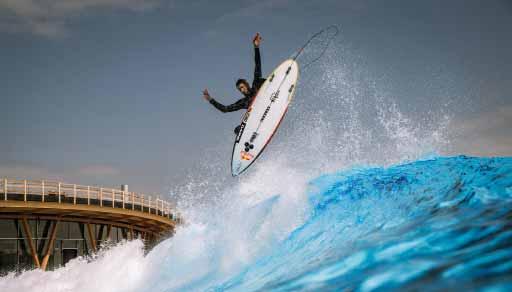
Endless Surf, a wave generation technology powered by WhiteWater, has revealed its stadium-sized surf lagoon - at O2 SurfTown MUC - in Munich, Germany.
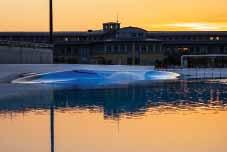
The wave technology featured at O2 SURFTOWN MUC, recently debuted its first waves to the world, showcasing immense power and customisability. From high-performance to beginner waves, the technology is capable of crafting waves to suit all surf levels, offering training potential for athletes while also making the dream of surfing attainable for those living far away from surfproducing coastlines.
SurfTown MUC is a 180-metre-long wave pool featuring four different surf zones, each allowing a maximum of 16 surfers simultaneously. One-hour sessions guarantee a minimum of 12 wave ride attempts per surfer.
Contact +1 833 913 2578, www.endlesssurf.com/

Pavigym marks 60 years of innovation and excellence
Pavigym, a leading provider of gym flooring solutions and interactive fitness technology, has marked its 60th anniversary of operations, during which it has installed over 5 million metre² of flooring worldwide - equating to more than 700 football pitches or 1.5 times the size of New York’s Central Park.
Since its inception in 1963, the company, based in the Spanish city of Alicante, Spain, has grown into a global benchmark in the fitness industry, setting standards for innovation, quality, and customer satisfaction for its commitment to high-quality solutions.
Over the past six decades, Pavigym has consistently demonstrated leadership in innovation and quality, applying its expertise in rubber across various industries. Originally a manufacturer of athletic shoe soles for renowned brands like Nike and Reebok, Pavigym strategically pivoted to focus on the fitness industry. The company specialises in creating tailored, trend-aligned solutions that enhance gym environments and meet the evolving needs of fitness facilities and their users.
Today, Pavigym boasts a team of over 100 professionals, six satellite offices worldwide, a vast network of more than 65 international distributors, and a presence in over 93 countries. In Australia, contact 0481 085 581, E: michael.smith@pavigym.com, www.pavigym.com


Studio SWEAT onDemand to launch in Australia at Ignite
2024
Online fitness leader Studio SWEAT onDemand (SSoD) has announced that it will be launching its commercial fitness program Sweat Pro in the Australian market at the upcoming 2024 Ignite Business Summit.
The event, being held at the Crowne Plaza Melbourne on 2nd and 3rd August will feature the SSoD’s new International Vice President, Edward Curtain, who will both address the conference as a guest speaker while also launching the product in the local market.
In business since 2012, SSoD created Sweat Pro to give commercial facilities unlimited access to over 2,000 of the best virtual fitness classes in the industry - to help them increase customers’ satisfaction, boost revenue and reputation, all while saving money.
The program is designed for a multitude of facilities, such as hotels and housing communities, schools and universities, military bases, large gyms and small fitness studios, among many others.
In attendance at Ignite will be several brand ambassadors of Studio SWEAT onDemand to help promote the launch and to help implement the service quickly and easily.
E: onDemandSupport@studiosweat.com, www.studiosweatondemand.com
Valo Motion launches new mixed-reality game for its immersive gaming room
Valo Motion, the pioneer in combining interactive technology with physical activities, has introduced Photobomb, the sixth mixed-reality game for its immersive ValoArena gaming room. The new title can be played by up to six players at a time and transports players to the glamour of a Hollywood movie premiere.
Founded in 2016, Valo Motion is a Finnish game company that designs, develops, and manufactures cutting-edge interactive MR/AR games and technology that help people find the joy of exercise. Valo Motion’s products ValoArena, ValoClimb and ValoJump are known for their high-quality and innovative design and are used in a variety of settings, including theme parks, arcades, and activity parks as well as in hospitality and retail locations.

Valo Motion’s ‘Photobomb’ delivers a fresh dose of laughter and excitement to location-based entertainment venues worldwide.
In Photobomb, the players take on the roles of celebrities arriving at a red-carpet event in a limousine. Each round, a picture frame appears, and players must rush to get into the frame before their snapshot is taken by the paparazzi that surround them. The goal is to be the most visible ‘star’ in the photographs, scoring points for face, hand, and feet markers captured in the frame. After 12 dynamic rounds, the player with the highest score becomes the star of the show.
Contact Valo Motion’s Australian distributor The Highgate Group on 02 9999 0055, E: admin@highgategroup.com.au, www.highgategroup.com.au

Leading aquatic product suppliers International Quadratics and Pierce Pool Supplies have revealed a refreshed name and logo - Interquad - for their group operations.
With International Quadratics and Pierce Pool Supplies having merged in 2008 to deliver everything in aquatics, both commercial and residential, under one roof, the new updated brand identity was designed specifically to highlight InterQuad’s values of trust, expertise, and fun.
A nod to the companies’ shared 150-year history, the new look and feel highlights InterQuad’s ongoing commitment to innovation and sets the future pool industry up for success.
InterQuad Marketing Manager, Marcelle Benjamin advised “our new branding and logo strike the perfect harmony between modern design and enduring tradition.
“The new identity not only reflects our commitment to excellence, but also amplifies our dedication to serving customers with distinction. The revitalised brand resonates with the quality and integrity at the heart of our products and services.”
The reimagined logo is a contemporary interpretation of the previous design, bidding farewell to the much-loved dolphin in favour of a dynamic Q-tail that represents the fun side of InterQuad, visually representing a waterslide or a wave.
Contact 02 9774 5550, E: sales@interquad.com.au, www.interquad.com.au


Grassports Australia presented with Sport Group Asia Pacific award
Grassports Australia’s project to construct a multi-purpose sport and recreation facility on the roof of the car park at St Kevins College Toorak in Melbourne has been judged as the best international project of the year at Sport Group Asia Pacific’s Annual Agent Conference.
Held at Cebu in the Philippines from 4th to 6th May, Grassports Australia’s project topped the list of 73 entrants.
Commenting on the win, Grassports Australia Managing Director, Bernard Evans stated “I am proud of my whole team and very proud to be acknowledged by our peers in the industry.”
Speaking about their awards, Sport Group Asia Pacific noted “the quality of projects continues to exceed expectations - your craftsmanship, creativity and ingenuity are what make you the leaders in this industry.”
Contact Bernard Evans on 03 9792 0622, E: bevans@grassports.com.au, www.grassports.com.au

PerfectGym joins Sport Alliance
Sport Alliance, the Germany-based provider of innovative software solutions and services to gyms and fitness suites, has announced the acquisition of Perfect Gym Solutions, the international software provider to aquatic, fitness and recreation businesses.
With the acquisition of PerfectGym, Sport Alliance strengthens its team and international capabilities and further enhances its ability to bring digital innovation to fitness and leisure facilities globally.
Together, the new entity represents the premier software provider for top fitness chains including servicing 14 out of Europe’s top 30 chains. It is also the market leader among facilities in Australia and services customers in over 130 international chains in more than 55 countries, spearheading the digital transformation of over 10,000 sports facilities globally.
Announcing the acquisition, Sport Alliance Chief Executive, Daniel Hanelt stated “we welcome PerfectGym into the Sport Alliance group. This is a significant milestone in supporting the fitness industry worldwide on its path towards further digitisation. Sebastian and his team bring valuable international expertise and incredible motivation to the group; we are very much looking forward to the journey ahead.”
PerfectGym Chief Executive, Sebastian Szalachowski added “PerfectGym has always been committed to shaping the fitness industry and providing leading solutions to enterprise customers and complex sports facilities.
“In Sport Alliance we have found a partner for growth who shares our mission, and we are eager to continue to expand together.”
Prior to the acquisition, PerfectGym announced a significant rebranding, signifying the business’ commitment to innovation and customer-centric solutions.
The cohesive visual identity captures the essence of the company’s mission and values, perfectly aligning with its ambitious goals of digital transformation in the aquatic, fitness and recreation industry.
Introducing the change, Szalachowski advised “at PerfectGym we continuously strive to enhance our brand presence and deliver unparalleled experiences to our customers and their members. As we expand our horizons, it’s essential to maintain a cohesive brand image that resonates with our diverse customer base worldwide.”
As part of the rebranding process, PerfectGym has also launched a revamped website, designed to offer an enhanced user experience and intuitive navigation. The vibrant design and streamlined interface provide visitors with easy access to essential information about the company’s services and solutions.
Contact 1300 088 922, E: info@perfectgym.com.au, www.perfectgym.com.au

Australia names Polytan and Rekortan brands as official track partner
With the nation’s elite athletes requiring world class tracks on which to develop and perform, Athletics Australia has announced Sport Group brands Polytan and Rekortan as its Official Track Partner.
Polytan is the largest sports surface installation business in Australia and their Rekortan track range has featured in Olympics, World Championships and Diamond League events.
Currently, 85% of all tracks in Australia are Rekortan track systems installed by Polytan.
The new three-year partnership announced by Athletics Australia, will see Polytan join forces to redefine the standards of track surfaces across the nation aiming to enhance infrastructure and facilities available to Australia’s growing athletics community, and improve the nation’s facilities footprint to better the sport.
Athletics Australia Chief Executive, Peter Bromley stated “from Olympic stadiums to local tracks, Polytan’s surfaces have set the standard for excellence within athletics and as we enter a golden era in Australia, this partnership will continue to elevate our sport.
“Polytan will have direct communication to our Member Associations, clubs, coaches and technical committees through forums, and we look forward to coming together on a joint strategy to build more infrastructure, including the potential for the country’s first short track site.”
Contact 1800 663 812, E: enquiry@polytan.com.au, www.polytan.com.au
Auckland-based ticketing company Eventfinda has launched TixSuite, a new ticketing model providing ticketing software via subscription, in Australia.

TixSuite’s ticketing system sells subscriptions to its proprietary software, giving venues, promoters, and event organisers control over their ticketing while buyers can pay zero per-ticket fees.
The current business model often sees legacy ticketing services holding all the cash from ticket sales until after the event, stalling cash flow for the event organiser.
This process creates challenges for promoters who must stump up significant capital, particularly at a time when buyers are waiting until the last minute to purchase tickets - creating uncertainty around the viability of events.
TixSuite enables users to collect 100% of their ticketing revenue up front, removing the financial burden and stress from promoters, venues and event organisers. E: sales@eventfinda.co.nz, www.eventfinda.co.nz

Clubfit Software announces acquisition of EZeMember (Platypus Software)
Leading cloud-based gym software provider Clubfit Software Pty Ltd has announced its completion of the acquisition of gym and studio management platform EZeMember.
Clubfit has been operating for over a decade as an Australian cloud-based gym software provider with strong growth in the health and fitness space. The acquisition adds to its growing portfolio of clients within Australia, which supports over 700 clubs.
Commenting on the sale, EZeMember Director, Phil van Diem stated “after several decades of operation, we felt that the time has come to retire.
“Our goal with EZeMember was to build a product that was focused on our customers’ needs, but not only that, to provide a high level of support to backup that product. To listen to our customers’ needs and promptly respond accordingly, remained our focus throughout.”
Clubfit is committed to continuing to provide its unique allin-one member management solution to the health and fitness market in Australia, with potential international expansion in the near future.
For further information contact 1300 148 361, E: sales@clubfitsoftware.com.au

A new innovation in amusement park and carnival ride safety is set to enhance and streamline operations in the attractions industry.
Created by Brisbanebased technology company Metrix and its founder Dylan Karaitiana, the digital logbook targets key aspects of operators’ businesses, from staff and asset management to training and compliance with operators who have used the technology reporting substantial improvements in efficiency and safety.
Karaitiana, from a family with generations of experience in amusement operations, states “our approach targets key aspects of an operator’s business, from staff and asset management to training and compliance (and) our solution does everything.”
With the impact of Metrix resonating with over 450 amusement operators, he adds “if you’re in this space, our solution will significantly enhance your operations.
“We recognise that smartphones and tablets are not just the future; they are the present. Every operator in the country is on the phone; they should have all their information easily accessible and ready to communicate.”
Looking forward, Metrix is deepening its commitment to enhancing staff training and competency, a move Karaitiana believes is crucial for the industry’s future.
Contact 07 3515 4132, E: hello@metrix-digital.com.au, portal.metrix-digital.com.au/
Artificial intelligence-powered sports technology company WSC Sports is introducing three new solutions to its product suite focusing on enhancing user engagement, with personalised content, formats and viewing channels.

WSC Sports’ ‘Around The Game’ product expands the company’s AI capabilities across in-game content with indexing and automating every aspect of the game, including fan reactions, player arrivals, sponsor logos, interviews, press conferences, and studio shows.
The In-App Stories product allows customers to insert a vertical video experience within owned and operated digital platforms, where fans can engage with content in a similar way to popular social media platforms.
Organisations will be able to automate the creation and delivery of vertical content in formats such as stories, vertical swipeable video feeds, polls, and quizzes.
The Discovery Network product increases rights holders’ content exposure by reaching fans on pre-agreed third-party sports properties to further expand monetisation opportunities. WSC Sports said the product gives rights holders full control to manage content distribution, generate exposure, drive traffic and maximise monetisation opportunities.
Contact +972 3 773 1660, wsc-sports.com/

Sports lighting company VAILO
extends partnership with AFL’s Hawthorn AFL club Hawthorn has announced that it has extended its partnership with LED sports lighting and LED signage partner VAILO.
Following an initial two-year partnership with the Hawthorn’s men’s and women’s programs, the extension will see VAILO continue as the official LED lighting and signage partner for Hawthorn’s AFL and AFLW programs.
VAILO has also recently been awarded the lighting contract for the development of the club’s new home base, the Kennedy Community Centre, including within the Community Pavilion and AFLW Oval.
Excited about its evolving partnership with VAILO, Hawthorn Chief Executive, Ash Klein stated “VAILO has supported the club in several ways since we began our partnership in 2022 and will continue to play a pivotal role in helping brighten our future home.
“This collaboration between Hawthorn and VAILO works in great unity. Like Hawthorn, VAILO pride themselves on forward thinking and creating innovative solutions therefore we look forward to continuing this journey with them.”
Established in 2012, VAILO has been dedicated to illuminating sporting venues nationwide with premium LED lighting and digital display solutions.
Contact: 1300 153 338, E: hello@vailo.com, www.vailo.com

Life Floor announces new NSW partner
Life Floor (Australia and New Zealand) Managing Director Grant Burgess has announced the appointment of Sydneybased Synthetic Grass and Rubber Surfaces Australia as Life Floor dealer representative and installer for NSW.
Burgess explained “with the ever-increasing awareness and acceptance of Life Floor we are needing more local representation and technicians to swiftly attend to the volume of enquiries we are receiving.
“Synthetic Grass and Rubber Surfaces Australia has forged a very solid reputation and align perfectly with our target market. We feel their depth of experience and broad customer base will further drive the Life Floor brand throughout NSW.”
Synthetic Grass and Rubber Surfaces Australia Managing Director, Mark Cunningham added “finally, there is a product in the aquatic industry that works and is fit for purpose. I believe this is really the only product that should be used in aquatic flooring. With a vast number of colours and designs you can let your mind run wild with designs. Our team is looking forward to showcasing this amazing product.”

Jonathan Keller, co-founder and Global Chief Executive of Life Floor, added “we remain steadfast in our belief that all aquatic spaces should be safe, beautiful, and accessible for all ages and abilities.
“To further increase access to Life Floor internationally, we rely on trusted, local partners to deliver on our mission and uphold our values. We’re thrilled about our new partnership with Synthetic Grass and Rubber Surfaces Australia to drive forward the success we continue to celebrate in New South Wales.”
Contact Synthetic Grass and Rubber Surfaces Australia on 02 9986 1133, E: sales@syntheticgrass.com.au, www.syntheticgrass.com.au
Contact Life Floor (Australia and New Zealand) on 1300 721 135, E: info@lifefloor.com.au, www.lifefloor.com.au
Send your product news to leisure@ausleisure.com.au

Subscribe to this magazine for just $99 (in Aus/NZ) for 12 months/six issues.
To subscribe go to subscribe.ausleisure.com.au

Axess grows by more than 10% in 2023 with global market leadership in the ski business Leading ticketing and access management system provider

Axess AG has advised that, for the first time, it has become the global market leader in one of its core business streams - ticketing and access solutions for mountain railroads and ski resorts. Since its foundation in 1998, Austrian-based Axess AG has developed a broad product portfolio providing ticketing and access systems for locations including ski resorts, theme and water parks, stadiums, exhibition centres and visitor attraction.
In the 2023 financial year, Axess increased its turnover for the 11th time in a row with an annual turnover of US$86.9 million achieving not only strong growth in ticketing and access solutions for mountain railroads and ski resorts but also in stadiums, leisure and attractions and trade fair and congress solutions segments.
In an online update, the company advised “many customers are enthusiastic about the innovations and new technologies, and the demand to switch to an Axess system is steadily increasing.
“The innovations and new technologies in 2023 include the use of BLE (Bluetooth Low Energy) as a replacement for traditional RFID tickets, which already offers skiers on many continents the opportunity to buy tickets directly from the online store and enjoy a day’s skiing without having to stop at ticket offices or ticket machines.
“In the stadium and leisure sector, there is also a clear trend towards modern and contemporary ticket technologies such as NFC (near field communication) or the use of biometric identification systems.”
Axess offers a variety of solutions, such as modern readers (certified by Apple & Google), as well as new opportunities through technology partnerships with innovative companies such as Amazon.
In Australia, the convenience of Axess systems is appreciated in ski resorts, theme parks and new customers such as Wollongong’s WIN Stadium and Newcastle’s McDonald Jones Stadium - operated by Venues NSW.
Contact Axess’ David Brown on 0411 726 330, E: d.brown@teamaxess.com, www.teamaxess.com

Short-form video hosting service TikTok has announced a partnership with AEG ticketing platform AXS to offer fans a new way to discover and buy tickets to live events.
Live in Australia, Sweden, the UK and USA, the partnership gives any Certified Artist on TikTok the ability to use the in-app ticketing feature to promote their AXS live dates and connect with fans around the globe.
The in-app feature empowers artists to promote their live dates to new and existing fans on TikTok, helping them expand their audiences globally and build their careers, simply by allowing them to add their AXS event links to their videos before publishing.
AXS Chief Strategy Officer, Marc Ruxin noted “TikTok has become one of the most important global platforms for music content attracting an incredible community of artists and fans.
“By combining the reach and influence of TikTok artists with AXS’ global ticketing platform, the partnership will provide seamless ticket-buying access to some of the world’s most iconic venues, festivals, and tours. This is the perfect example of discovery-driven content and commerce for music fans.”
AXS has also announced that it has acquired a majority stake in WRSTBND, a leading provider of access control, credentialing and point-of-sale solutions for live events and venues. Details at www.axs.com/au
Xplor introduces Mariana Tek boutique fitness platform in Australia and New Zealand

Xplor Technologies is expanding the availability of its Mariana Tek gym management software fitness in Australasia and the United Kingdom.
One of a number of technology brands acquired by private equity group Advent International in recent years, it is described as offering “a true enterprise business management platform ... for large and emerging brands.”

The software platform enables studios to curate and customise the branded experience they offer customers, both in-studio and online.
A custom app enables members to book a class, bring a guest, use geolocation to check-in, preorder, purchase items, select their favourite reformer, bike or mat in the studio, as well as being able to add themselves to class waitlists.
Founded in Atlanta, Georgia, USA, Mariana Tek was acquired by Advent in 2019 and, having previously focussed on the North American market, is now looking to expand globally.
E: sales@xplortechnologies.com, www.xplortechnologies.com/au/products


Evolt and EGYM unveil cutting-edge technology fusion
Advanced body composition analytics pioneer, Evolt, has partnered with digital fitness solutions company, EGYMrepresenting a pivotal shift within the industry as individuals increasingly adopt a holistic approach to health.
The collaboration, announced recently at IHRSA in Los Angeles, merges EGYM’s fitness equipment and digital platform with Evolt’s advanced composition analysis technology, offering gym members comprehensive insights into their health and fitness.
Through seamless integration with the EGYM platform, users will gain direct access to Evolt’s body composition analysis, empowering them to monitor progress, establish personalised goals, and make well-informed decisions regarding their fitness and nutrition strategies.
Evolt co-founder and Chief Executive, Ed Zouroudis said the EGYM partnership marked a milestone in data-driven fitness journeys, advising “this collaboration represents a significant stride towards integrating technology into the fitness landscape. By synergising our expertise with EGYM’s robust platform, we offer users a comprehensive solution to optimise their health and fitness outcomes.”
With global headquarters in Burleigh on Queensland’s Gold Coast and with a presence in 43 countries and a user base nearing two million registered users, Evolt continues to expand its global reach.
Contact 07 5535 6227, E: info@evolt360.com, www.evolt360.com
Vivaticket partners with Mashfrog Group to develop new digitalisation opportunities for sport
Ticketing and access control solutions provider Vivaticket has announced that it has partnered with Mashfrog Group to release Ticket Wallet, a completely customisable solution which enables sports teams to control venue access digitally.

The result of integrating Vivaticket and SSO technology, Ticket Wallet enables fans to access a sports venue by showing a QR code on their mobile device while benefitting from services such as bespoke content, gamification, push notifications and special offers.
Additional benefits include improved safety in managing venue tickets, reliability during network overload and blackout conditions, and an enhanced fan experience.
With the first operational rollout of Ticket Wallet showing more than 10,000 downloads in just a few days, Vivaticket Chief Executive, Silvano Taiani advised “we believe this partnership represents a fundamental step in the evolution of the sports market. The direction that the entertainment world has taken for some years now is to guarantee a complete and all-encompassing experience for its fans.”
Contact 1300 682 203, E: sales.au@vivaticket.com, www.vivaticket.com



Myrtha Pools celebrates success of SWELL Palmerston
Myrtha Pools has shared the success of its work at Palmerston’s new Swimming, Wellness, Events, Leisure and Lifestyle (SWELL) precinct.
With the anticipation of significant population growth in the Darwin suburb over the coming decade, in 2020 the City of Palmerston commenced planning for the refurbishment of its 40-year-old, 50-metre concrete pool, which was reaching the end of its lifecycle.
The Council saw a prime opportunity to integrate Myrtha Pools’ Renovaction technology in the rejuvenation of the facilities, with the full project including a refurbished 50-metre pool incorporating a ramp for accessibility, a 20-metre warm water program pool and a splashpad and play area along with an events area, basketball half-court, new and improved accessible toilets and change rooms and a two-story aquatic adventure play structure.
Constructed by Adelaide-based builder Hydrilla - its largest project and marking the City of Palmerston’s most significant infrastructure endeavour, the project’s build duration was 16 months.
Myrtha Pools ANZ Business Development Manager, Chiara Cenati advised “this initiative has been a catalyzer and aims to address an anticipated surge in demand while ensuring community safety.
“Providing safe and accessible pools serves as a crucial measure to deter swimming in rivers and lakes, which may harbour crocodiles.
“By providing safe and complimentary swimming facilities, SWELL Palmerston plays a vital role in decreasing the likelihood of drownings, particularly among children and inexperienced swimmers.
“Moreover, it redirects recreational pursuits to regulated environments, fostering overall well-being.”
Cenati added “we’re incredibly proud of the successful completion of SWELL Palmerston with Myrtha Pools and the positive impact it will have on the Palmerston community.”
Another innovative feature at SWELL Palmerston is Australia’s first two-storey aquatic course from WhiteWater West.
Contact Chiara Cenati of Myrtha Pools on 0499 715 085, E: chiara.cenati@myrthapools.com, www.myrthapools.com

Empowering events and venues by supplying comprehensive software and hardware solutions that deliver better visitor experiences, increased efficiency and enhanced revenue growth, Sendrato has this year transformed the digital experience for the Sydney Royal Easter Show.
Building the frontiers of payment technology for amusement, attractions and events industries, Sendrato’s convergence of science and engineering expertise has enabled the company to develop the Ludo leisure system, a paradigm shift in event management technology.
A comprehensive venue management system designed for concession holders, integrating a hybrid closed-loop and open-loop system, the Ludo leisure system uses RFID and QR-based wallets alongside payment solutions including Visa and Mastercard to support preorder functionalities for food and beverage services, enhancing overall customer satisfaction.


Introduced at the Sydney Royal Easter Show in 2022, Sendrato’s visitor app is a testament to innovation, incorporating wallet functionalities and venue mapping with augmented reality navigation, all of which are administrated through a user-friendly back office.
This allows for a fully customised app to be deployed swiftly - within days, not months.
For point of sale (POS) complexities, Ludo offers robust solutions tailored for various outlets like concert merchandise, showbags, and restaurants. It provides absolute ease and automation on the customer-facing device, streamlining the sales process.
This year’s Royal Easter Show deployment featured over 400 hundred remotely configured POS terminals and over 3,000 scheduled events available for visitors to explore and bookmark in the app.
Contact Bart Wildash, Sendrato APAC Director on 0400 110 506, E: bart@sendrato.com.au, www.sendrato.com.au

When Sofitel Sydney Wentworth reveals its $60 million refurbishment this spring, among the impressive innovations will be cutting-edge technology provided by Encore Event Technologies.
Encore is also the in-house event production and AV partner for some of Sydney’s best hotels and function venues including Accor Stadium, CommBank Stadium, Q Station Hotels Manly, and Taronga Zoo.
The highlight of Sofitel Sydney’s technological upgrade is the installation of one of Australia’s largest LED screens in the Grand Ballroom, complemented by digital screens and LED upgrades throughout all meeting spaces.
New additions in all event spaces will feature state-of-the-art lighting, presentation, and staging technology. They will also be equipped with bright wide-screen projection systems, crystal-clear sound systems and customisable lighting solutions. Sofitel’s in-house experienced technical organisers can assist with all production elements, from show calling to room theming and design, ensuring a seamless and immersive experience for attendees.
Contact: 1800 209 099, www.encore-anzpac.com/





